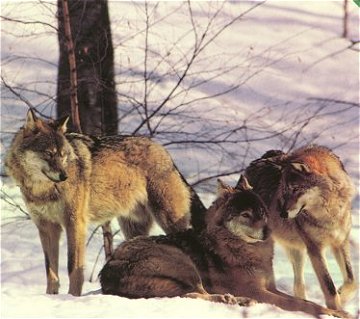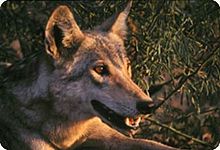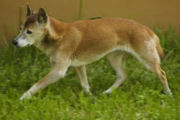This site was last updated on 01 October 2008
The Evolution & History of Wolves
No animal on this planet has evoked more
fear and respect from mankind than the wolf.
Our ancestors heard its
howl. Once again its howl is heard throughout eastern Canada.
It has
returned, smarter and more resourceful than before, and it is staying this time.
This story begins 40 million years ago in North America

Eucyon, the ancestor of all known living Canids
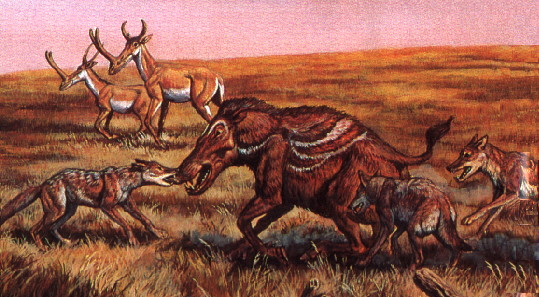
Wolves, Coyotes, and Their Hybrids
A new species of Wolf has evolved in eastern Canada
Eocene epoch: The Canidae family evolved from miacids about 40 million years ago in the late Eocene to early Oligocene. The Canidae family is subdivided into three subfamilies, each of which diverged during the Eocene: Hesperocyoninae (~39.74-15 mya), Borophaginae (~36-2 Mya), and the Caninae lineage that led to present-day canids, including wolves, foxes, coyotes, jackals, and domestic dogs.
Oligocene epoch: The earliest branch of the Canidae was the Hesperocyoninae lineage, which included the coyote-sized Mesocyon of the Oligocene (38-24 mya). These early canids probably evolved for fast pursuit of prey in a grassland habitat, and resembled modern civets in appearance. Hesperocyonine dogs became extinct except for the Nothocyon and Leptocyon branches. These branches lead to the borophagine and canine radiations.
Miocene epoch: Around 9-10 mya during the Late Miocene, Canis, Eucyon, and Vulpes genera expand from southwestern North America. This is the point where canine radiation begins. The success of the these canines is the development of lower teeth structure that are capable of both mastication and shearing. Around 8 mya, Berengia offered the canids a way to enter Eurasia, opening up vast new territories to colonize, mingle, and improve.
Early Pliocene: During the Pliocene around (4-5 mya), Canis lepophagus appeared in North America. This dog was small with some being coyote-like. Others were wolf-like in characteristics. It is theorized that Canis latrans (coyote) descended from Canis lepophagus. Around 1.5 to 1.8 mya, a variety of wolves were in Europe. Also, the North American wolf line appeared with Canis Edwardii as clearly identifiable as a wolf. Canis rufus, the Red wolf canine appeared (possibly a direct descendent of Canis edwardii).
Middle Pliocene: Around 0.8 mya, Canis ambrusteri, emerged in North America. A large wolf, it was found all over the continent. It is thought that this species spread to South America where it became the ancestor of the Canis dirus or Dire wolf.
Dire wolf Canis dirus (extinct)
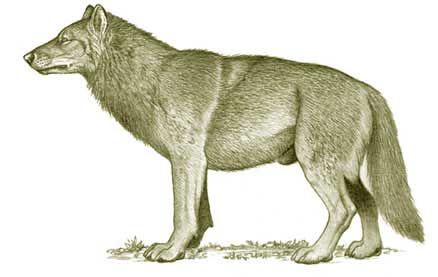
The Dire Wolf, more muscular and heavier than the Grey wolf, evolved earlier, and the two co existed in North America for about 400,000 years. As its prey became extinct around 16,000 years ago due to climatic change, the dire wolf gradually became extinct itself. Around 7,000 years ago, the Grey wolf became the prime canine predator in North America. The Dire wolf has no known descendent alive today with the possible exception of the South American Bush Dog.
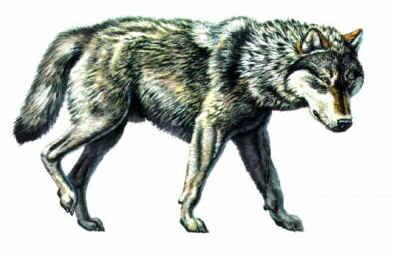 They were abundant approximately 10,000 years ago, and became
extinct along with most other North American giant animals (megafauna). The vast
majority of fossils recovered have been from the La Brea Tar Pits in California
and in Florida. It averaged about 1.5 metres (5 feet) in length and weighed about 50
kilograms (110 pounds), though large specimens may have weighed as much as 80kg
(175 pounds). Some Grey wolves were taller, and they all
were faster than this fellow.
They were abundant approximately 10,000 years ago, and became
extinct along with most other North American giant animals (megafauna). The vast
majority of fossils recovered have been from the La Brea Tar Pits in California
and in Florida. It averaged about 1.5 metres (5 feet) in length and weighed about 50
kilograms (110 pounds), though large specimens may have weighed as much as 80kg
(175 pounds). Some Grey wolves were taller, and they all
were faster than this fellow.
The Dire wolf had a larger, broader head and smaller brain-case than that of a similarly-sized Grey wolf, and had teeth that were quite massive. Many paleontologists think that the Dire Wolf may have used its relatively large teeth to crush bone, an idea that is supported by the frequency of large amounts of wear on the crowns of their fossilized teeth. Dire wolf skeletons have been found bearing healed and half-healed injuries similar to the ones found on modern wolves who have been injured while hunting large prey, indicating the Dire wolf also hunted large, live prey.
In total, fossils from more than 3,600 individual Dire wolves have been recovered from the tar pits, more than any other mammal species. This large number suggests that the Dire wolf, like other Canines, probably hunted in packs. It also gives some insight into the pressures placed on this species near the end of its existence.
The Dire wolf never made it to Asia even when there was a land bridge in Berengia. It was a warm-weather animal, used to the thick tropical and sub-tropical forests, and had little inclination to venture into the icy north country plains and tundra where huge herds of Bison and Caribou might have saved it from extinction. No remains of this wolf have ever been found in northern Canada. Where Grey wolves followed migrating herds, the Dire wolf would have been stationary thereby limiting its food source to its known territory. When its prey died off, it disappeared also.
Late Pliocene: At 300,000 years ago, Canis lupus (the Grey wolf) had fully developed and had spread throughout Europe and northern Asia. Berengia offered a way back to North America. At around 100,000 years ago, the Dire wolf, some of the largest members of the dog family, appeared from southern Canada to South America and coast to coast. The Dire wolf shared its habitat with the Grey wolf. Around 7000 - 8000 years ago the Dire wolf became extinct, leaving the continent to the Grey wolf to exploit.
Characteristics: Wild canids are found on every continent, except Antarctica, and inhabit a wide range of different habitats, including deserts, mountains, forests, and grassland. They vary in size from the Fennec fox at 24 cm in length, to the Grey wolf, which may be up to 200 cm long, and can weigh up to 80 kg (180 lbs).
With the sole living exception of the Bush dog, Canids have relatively long legs and lithe bodies, adapted for chasing prey. All canids are digitigrade, meaning that they walk on their toes. They possess bushy tails, non-retractile claws, and a dewclaw on the front feet. They possess a penis bone, which together with a cavernous body helps to create a copulatory tie during mating, locking the animals together for up to an hour. Young canids are born blind, with their eyes opening a few weeks after birth.
Many species live and hunt in packs, and have complex social lives. They are generally highly adaptable, and there may be considerable variation in habits even within a single species.
Modern day wolves: Exhaustive research and dna testing of genetic signatures of wolves throughout North America has recently resulted in a new perspective of North American wolf and coyote populations. The presumed theory until recently was that the Red Wolf (Canis rufus) was restricted to the south eastern US, and the larger Grey Wolf (Canis lupus), was to be found in the northern half of the continent. That is now recognized as not being accurate, eg. the Mexican wolf is a subspecies of the Grey wolf. Also Red wolves are found in eastern Ontario, Canada. In the far south, Canis rufus evolved into the Maned wolf of South America. Isolated by geography, it developed its unique adaptive physical characteristics.
(Author's note: Why the difference between Grey and Gray? Grey is the proper British term, according to the Oxford dictionary. Gray is the revised American choice, according to Webster's dictionary. In Canada, both are used. Since the majority of English-speaking peoples use the British term, in this story, Grey is used to avoid confusion.)
The Bering Land Bridge (Beringia) explained in simple terms
Modern science believes that Ice ages are brought about by changes in the tilt of the earth, as variations in CO2 levels can not explain the absolute rythmatic nature of known ice ages. By studying ice cores, it is known when the most recent ice ages began:
It is also known that the ocean level dropped by about 150 meters during each ice age. The lowest depth in the Bering sea is about 47 meters. By studying pollen in sediment at the bottom of the Bering sea, it is known there was still a land bridge across the Bering sea as late as 11,000 years ago.
.
The areas in the above chart with a blue background are recognized ice ages, when the Bering sea was dry for about 1,000 miles in latitude (north/south), and was covered with land grasses, brush and trees similar to what is found in Alaska today.
It is also known that Amerindians crossed from Asia into North America beginning about 23,000 years ago in three distinct waves of migrations. This fact is proven by tests of teeth structure of many diverse native cultures.
Author's note on the reasons of the wolf's success. Among the classifications that man has placed on animals is that which explains their eating habits. Those that specialize on a narrow range of prey are referred to as "specialists". Those that are not fussy what they eat are considered to be "generalists". By their very nature, generalists are also considered to be "opportunists". Most wolves are opportunists.
Whenever a species of carnivore has become a specialist, it has unalterably linked its future to that of its prey. As long as the prey species flourishes, its specialist predator will flourish. When the prey species disappears, its specialist predator disappears with it. An example of this relationship is the Cheetah and its prey; the Gazelle and the Gnu. It is known by DNA testing that at one time the Cheetah almost disappeared. All surviving Cheetahs today are so close in their dna that they could be brothers of the same family. That situation could only happen if a catastrophe caused their prey species to disappear resulting in mass extinction. The one family of Cheetahs that did survive repopulated the species.
This catastrophe could never happen with wolves as they are opportunists, and will instinctively go after any prey with protein in it. They will even resort to eating roots and grass. The most lethal enemy of wolves is man. If man were to disappear, the wolf would soon regain its rightful place at the apex of the food chain. The only exception to this logic is if a population of wolves becomes addicted to a certain prey to the exclusion of all others. If that happens, that population of wolves would become embedded with their prey and its future
The reason for the eradication of Grey wolves from much of its traditional territory in North America was due to its inability to adapt. It was a creature of habit, and it became tied to its larger prey, and its habitual ways. When the Bison, Caribou and Moose became scarce the Grey wolf perished or moved on while the fate of the Coyote took a different turn. Where a pure wolf will seek isolation from man, the Coyote will thrive in an urban setting. It is a typical contest between brawn and brain, where brain will inevitably win out.
Originally driven from the best hunting grounds, the Coyote evolved into an opportunist lifestyle. Hunting alone, it came to depend solely on its wits. Unlike the wolf, it did not depend on its strength, nor its numbers not even its speed, but its wiles. eg. It has been documented that a Coyote will cooperate with a Badger to catch a rabbit in its underground burrow. In times of scarcity, it would eat grass. Its main diet became mice, moles and small rodents, even grasshoppers. It thrived on its wits and was never eradicated from any of its traditional haunts. When under pressure, it reacted by having two litters a year, and became a better parent.
Unlike the wolf, a mother Coyote (or wolf/coyote Brush wolf) will tolerate another lactating female in her pack. Even in Yellowstone National Park, where Grey wolves were reintroduced from Canada, and despite a devastating decease in their numbers due to wolf predation, the resident Coyote population has quickly evolved and has learned how to take advantage of the presence of its nemesis.
When Red and Grey wolves, were eradicated from much of southern and eastern North America, the stage was set for one of the greatest recent natural expansions of range of any carnivore on earth. Whether that expansion is complete, is anyone's guess.
Coyotes Canis latrans
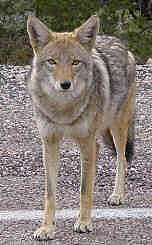
|

|
In Canada, the coyote still inhabits its traditional habitats, the aspen parkland, and short mixed-grass in the three prairie provinces. However, due to the eradication of its larger nemesis, the Grey wolf from much of its former territory, the coyote has spread north to the shores of Hudson Bay, west to the Pacific, and east into Ontario, Quebec, and all four Atlantic provinces.
Coyotes entered Vancouver about 1980 and are now established in the confines of greater Vancouver, both in Stanley Park and about the many golf courses in the city.
The Coyote hybridized
with the northern Red wolf in and
around Ontario's Algonquin Park, has become a more efficient hunter, and
continued spreading east
into Newfoundland. Subsequently, in eastern Canada, where regrowth forests and brush land
on abandoned farmlands does not
favor lone hunters, packs of "Brush wolves" have assumed the pack lifestyle of
their larger wolf cousins.
This
has never sat very well with some naturalists, due to some well known facts regarding
Coyote and Wolf hybridizing in eastern North America.
Reproduction: Female coyotes are monoestrus, and remain in heat for 2–5 days between late January and late March, during which mating occurs. Once the female chooses a partner, the mated pair may remain temporarily monogamous for a number of years. Depending on geographic location, spermatogenesis in males takes around 54 days and occurs between January and February. The gestation period lasts from 60 to 63 days. Litter size ranges from 1 to 19 pups; though the average is 6. These large litters act as compensatory measures against the high juvenile mortality rate, with approximately 50 -70% of pups not surviving to adulthood. Under stress, a female Coyote will have more pups. This unique peculiarity is one major reason why they are so successful.
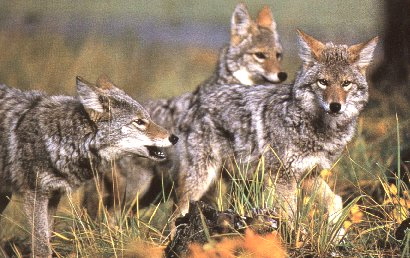 The pups weigh approximately 250 grams at birth and are
initially blind and limp-eared. Coyote growth rate is faster than that of
wolves, being similar in length to that of the Dhole. The eyes open and
ears erect after 10 days. Around 21-28 days after birth, the young begin to
emerge from the den and by 35 days they are fully weaned. Both parents feed the
weaned pups with regurgitated food. Male pups will disperse from their dens
between months 6 and 9, while females usually remain with the parents and form
the basis of the pack. The pups attain full growth between 9 and 12 months.
Sexual maturity is reached by 12 months
The pups weigh approximately 250 grams at birth and are
initially blind and limp-eared. Coyote growth rate is faster than that of
wolves, being similar in length to that of the Dhole. The eyes open and
ears erect after 10 days. Around 21-28 days after birth, the young begin to
emerge from the den and by 35 days they are fully weaned. Both parents feed the
weaned pups with regurgitated food. Male pups will disperse from their dens
between months 6 and 9, while females usually remain with the parents and form
the basis of the pack. The pups attain full growth between 9 and 12 months.
Sexual maturity is reached by 12 months
In the 1990s, the Ontario government relocated several Grey wolves into south eastern Ontario to help reintroduced Fishers and Cougars in thinning out the overabundant population of White tailed deer, which were being killed on the highways in astounding numbers. In Lanark County alone, it has been estimated that one deer is killed every day on highways.
Solitary male wolves invariably mate (during the last two weeks of February) with any obliging female wolf or coyote they can find. In one instance near Perth, one stationary pack of "Coyotes" was DNA tested. It was determined the Alpha male was a pure Grey wolf, the Alpha female was a Coyote. It has never been found to have occurred the other way around, so it appears that female wolves and coyotes favour larger males. This is now a universally recognized trait of all female coyotes and wolves.
It is now generally accepted that this has been the pattern in and around eastern Ontario since the early 1900s.
The progress of this dramatic "invasion" has been carefully charted; for example, coyotes established themselves in Ontario about 1919. Their Coyote/Red wolf hybrid offspring entered Quebec in the 1940s, in New Brunswick in the 1960s, Nova Scotia in the early 1970s, across the ice to PEI in the late 1970s, and across the winter ice of the Gulf of St Lawrence to Newfoundland by 1985. This remarkably fast expansion was due to the fecundancy of the female Coyote who can theoretically spark a population boom of over 1,000 in three years.
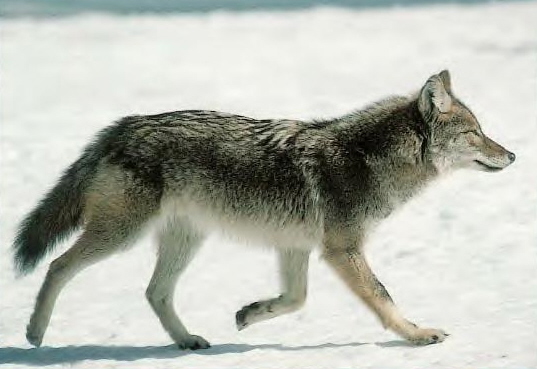 Most astonishingly, coyotes
have been discovered on the shores of Hudson Bay to Panama, and from Alaska to
Newfoundland & Labrador.
They have frequently interbred with southern and northern Red wolves to reclaim their
ancient territories. Pure Coyotes have often found it necessary to penetrate into
U.S. and Canadian cities to escape the predations of their larger
'country-style' hybrid cousins. In their urban haunts, their life
expectancy is doubled.
Most astonishingly, coyotes
have been discovered on the shores of Hudson Bay to Panama, and from Alaska to
Newfoundland & Labrador.
They have frequently interbred with southern and northern Red wolves to reclaim their
ancient territories. Pure Coyotes have often found it necessary to penetrate into
U.S. and Canadian cities to escape the predations of their larger
'country-style' hybrid cousins. In their urban haunts, their life
expectancy is doubled.
During the Autumn of 2007, Ottawa newspapers were full of reports of urban Coyotes killing domestic cats and dogs in the southern fringes of that city. Most of those reports were exaggerations and pure sensationalism (similar to the exaggerated claims of Coyote damage in Newfoundland).
Perhaps with the absence of pure Grey wolves in Newfoundland and the presence in large numbers of Moose and Caribou, Newfoundland may yet be the area where these shape shifters could become the largest Brush wolves in the world. If a new land bridge or even an ice bridge appears across the Bering straight in the foreseeable future, the way will be open for these purely North American opportunists to overwhelm Asia and Europe.
These Coyote/wolf descendents employ the craftiness of the coyote and the pack behavior & strength of the wolf to become a far more lethal threat to domestic livestock than either of its predecessors.
There has been substantial controversy on whether the North American Coyote should, or should not, be classified within the Jackal species. Some go so far as to describe the Coyote as the North American Jackal. One thing is for certain, both Jackals and Coyotes are bonafide members of the Canid family and actually predate wolves. In other words, Jackals (and Coyotes) were the ancestors of all wolves.
The 19 recognized subspecies of Coyote (to date):
-
Mexican Coyote, Canis latrans cagottis
-
San Pedro Martir Coyote, Canis latrans clepticus
-
Salvador Coyote, Canis latrans dickeyi
-
South-eastern Coyote, Canis latrans frustor
-
Belize Coyote, Canis latrans goldmani
-
Honduras Coyote, Canis latrans hondurensis
-
Durango Coyote, Canis latrans impavidus
-
Northern Coyote, Canis latrans incolatus
-
Tiburon Island Coyote, Canis latrans jamesi
-
Plains Coyote, Canis latrans latrans
-
Mountain Coyote, Canis latrans lestes
-
Mearns Coyote, Canis latrans mearnsi
-
Lower Rio Grande Coyote, Canis latrans microdon
-
California Valley Coyote, Canis latrans ochropus
-
Peninsula Coyote, Canis latrans peninsulae
-
Texas Plains Coyote, Canis latrans texensis
-
North-eastern Coyote, Canis latrans thamnos
-
Northwest Coast Coyote, Canis latrans umpquensis
-
Colima Coyote, Canis latrans vigilis
Note: This list is growing, and more subspecies will be added as this purely "North American" canid breaks into South America.
Coydogs and Dogotes
The existence of true coyote dog hybrids, also known as Coydogs or Dogotes, is often the subject of hot debate. This is because, at first glance, the facts seem to be a little contradictory. For instance, there is little scientific evidence of coyotes and dogs breeding in the wild. However, it is a genetic fact that coyotes can breed with dogs and wolves, subsequently producing fertile offspring.
The coyote social structure is somewhat different from the domestic canine, and coyotes would rather eat a dog than befriend one. Coyotes also have very different breeding cycles and mating behaviors. It is believed the male coyote sperm count remains low or dormant for most of the year, and only picks up for about 60 days (maximum) in the Spring in conjunction with the female coyote's once a year heat cycle. Coyote males usually stick with one female through the breeding season as well, even assisting in feeding and raising the puppies.
Some researchers believe they mate for life. Any domestic dog that would have the nerve to solicit the affections of a female Coyote would have to deal with a very irate male Coyote. Then, a female Coyote would have to be very hard up to breed with a lazy non-parenting dog, which in normal circumstances is just something to scorn or eat.
For a coyote and a dog to mate, the choice of female coyotes would have to be so sparse that the male would not have a "girlfriend" to start with, then, he would have to meet a female dog (too large to eat), who just happened to be in heat within the same two month period that he was producing sperm. The above scenario is not impossible, merely impractical.
A Coydog is an offspring from a male Coyote and a female dog. A Dogote is the offspring from a male dog and a female Coyote. So why aren't Coydogs more common? The reason there is little evidence of coyotes mating with dogs in the wild is simply because social habits and statistics makes the opportunity and probability of mating quite low.
Even in the rare occasions when a Coyote and a Dog have mated, the offspring would be fertile but their chances for survival in the wild are practically nil. Even if a litter of Coydogs makes it to breeding age there are more barriers. They inherit the coyote’s annual estrus pattern with one notable derivation - thanks to the good sense of mother nature; The male and female Coydog and Dogote comes into estrus in the Autumn, three to four months before the estrus cycle of wild coyotes. Their only viable mates are either domestic dogs or other Coydogs so once again, pickings are slim.
Then, any litter born to a Coydog or a Dogote would be born in the dead of winter, drastically lessening their chances of survival. Add to that the fact that the male Dogote takes after his daddy - no child-rearing skills - in the wild, these hybrids are an evolutionary dead end.
Evolution of Red
wolves Canis rufus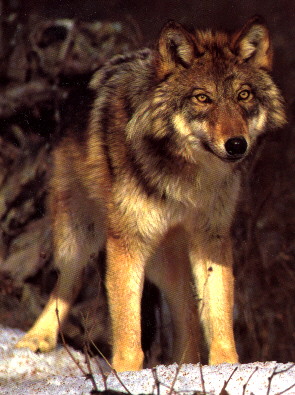
Untouched by any possible hybridization with Asian canines, the Red wolf of North America, is the older form compared to the Grey wolf.
It was their transient descendent, the Grey wolf of Asia and Europe, that was first domesticated by man and eventually became the household dog, Canis familiaris.
Through the ages, Red wolves hunted in packs and the smaller Coyote was pushed into south western fringe areas where food was scarce and a solitary life-style was necessary.
When new ice ages appeared, and the Bering land bridge returned, some Asiatic Grey wolves returned to their old stomping grounds in North America, following migrating herds of Moose, Elk and Bison.
Until recently, Red wolves were thought to have survived only in the southeastern United States, where they are so endangered they were proclaimed extinct in the wild by the US Wildlife Service in 1980.
The southernmost population of Grey wolves still existing is represented by the Mexican wolf.

There have always been incidents of Grey wolf/Red wolf hybridization in areas where they are in proximity but those populations were relatively scarce and fleeting, eventually replaced with the larger Grey wolf.
DNA tests proved that stuffed wolves exhibited in the north-eastern U.S. at hotels and lodges are actually specimens of the Red wolf. Further studies resulted in recognition of Red wolf subspecies populations in Texas, Mississippi, the Carolinas, and Florida. They remain under intensive scrutiny by wildlife Officers.
A program of captive breeding and reintroduction to the
wild has met with mixed results, as often, the reintroduced animals will readily
hybridize with expanding populations o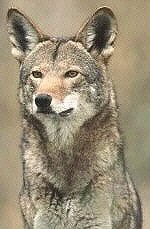 f Coyote.
f Coyote.
At the beginning of large scale agriculture in eastern Canada, forests were cleared, enticing the Virginia White-Tail Deer northwards. Remnants of the north-east U.S. Red wolf population followed them. Their population centre, and refuge quickly became Algonquin Park in north-eastern Ontario. Tests have proved there were no Red Wolves in this part of Canada prior to the early 1800s. This isolated population comprises the third known population of pure Red wolves on the planet, and it is the southernmost viable population of Red wolves.
Now that second and third isolated populations of Red wolves have been documented in western and eastern Canada, U.S. authorities could use their bloodlines to augment the southern population, and thereby strengthen their genetic pool. However, U. S. parochialism prevents that.
It is not known how many "southern Quebec" pure red wolves remain, or even if this is a viable population. Their viability as a pure strain in south-eastern Ontario is threatened by hybridization with Coyotes inside and outside of Algonquin Park.
To learn more about northern Red wolves, read "Wolf Country" by John B. Theberge (ISBN 0-7710-8563-X.
Through an ironic twist of fate, the smaller Coyote (who was driven out of the best hunting areas by the Reds) has now (through its recent hybridization with Reds) spread its genes throughout eastern North America, an area that is entirely new to its species.
And in another testament to the endurance of the Coyote, most people in these newly expanded areas (except in south-eastern Ontario) refer to the new Brush wolves as "Coyotes". The Americans refer to them as "Coydogs". Similar to their transient cousins in Atlantic Canada, they weigh in at 50 - 60 lbs. To see the Brush wolves that live around my farm, scroll down to "Two Solitudes".
In Canada, there is no such thing as an
"Endangered Species Act". Due to the mine field of
Federal/Provincial politics in this country, the Feds finally hacked out a
"Species at Risk" Act which does not ruffle any Provincial
feathers.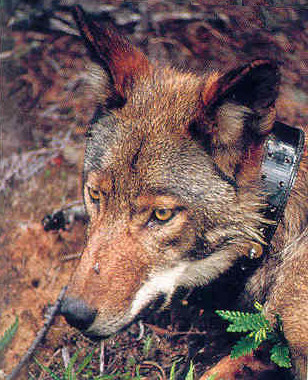
It appears our Federal and Provincial Governments are so arrogant and so tied up in their own "fiefdoms" they cannot contemplate the need for protection of endangered species, nor even to accept the fact that there are wolves in Canada of several species, that require Government protection.
Over time, with each population separated, the northern and southern populations of Red wolf have undoubtedly become substantially different and are already considered separate sub-species of the Red wolf.
The northern Red wolves are substantially larger, darker, and with smaller ears than their southern cousins, typical adaptations of any northern subspecies.
They also form permanent family packs (as do the Grey wolves), while their southern cousins generally do not (they don't have to). (Packs of northern Red wolves have been documented as killing moose.)
Through DNA testing, it has been documented that 13% of the resident Red wolf population in Algonquin Park has been infiltrated with Coyote dna.
Unless checked, this trend may eventually result in the complete extinction of the eastern pure Red wolf population in Canada.
Although this prospect may bring foreboding to some purists, it signals an ironic twist of fate for both the Coyote and the Red wolf.
The vitality and cunning of this new hybrid is remarkable, combining the best of both species.
The fact is each species needed the other to become something better so they could expand their population to areas previously lost by pure Greys.
Canada's Pacific Coastal Wolves
(Subspecies
yet to be determined)
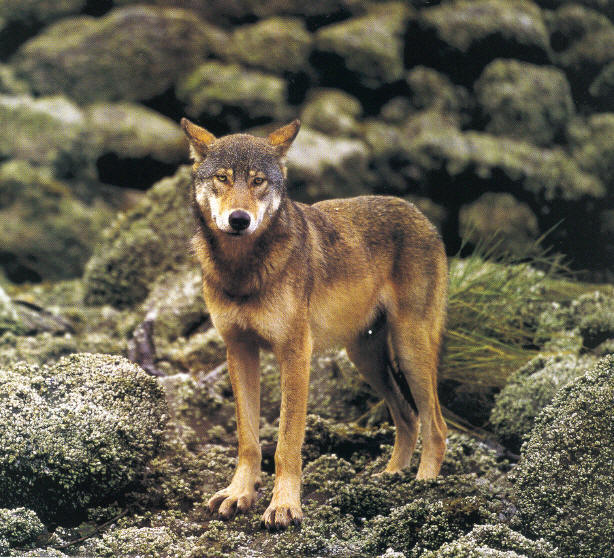
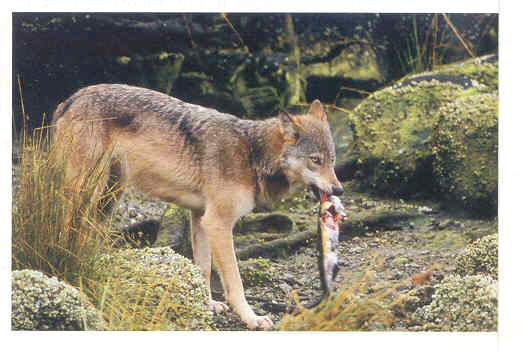 There remains an isolated population of Red wolves in the rain forests of the
islands off the coast of British Columbia, where it is estimated there are approximately about 500 still
remaining. Where their territories overlapped, some hybridization with
Greys occurred.
There remains an isolated population of Red wolves in the rain forests of the
islands off the coast of British Columbia, where it is estimated there are approximately about 500 still
remaining. Where their territories overlapped, some hybridization with
Greys occurred.
They regularly swim from one island to another, and one was documented swimming a distance of 11 km.
These coastal "marine-adapted" wolves comprise the second isolated population of Red wolves in North America.
Although there aren't good estimates of the total population of wolves in coastal British Columbia and Alaska, experts estimate that wolves in southeastern Alaska's vast Alexander Archipelago number fewer than 1000.
Conservationists worry that Government
subsidized logging of the ancient coastal forests poses a threat to these
animals and other wildlife in the region Some naturalists have insisted the B. C.
Coastal wolves are
actually Grey wolves but a comparison of these photos with that of the collared Red
wolf in Algonquin Park immediately above this section indicates to me these are
actually Red wolves. 
It has been reported that these wolves will not hesitate to howl in agitation if humans attempt to cross the river which partitions a logged area from an untouched area. Who can blame them?
From their observations and the work of other scientists, researchers say that Canada's coastal wolves generally appear smaller than their continental cousins. This may be because their primary prey, the Sitka black-tailed deer, is much smaller than the prey of wolves living elsewhere, or it may be because Red wolves are naturally smaller than Grey wolves..
Coastal wolf hair also appears to be coarser and better at shedding water, perhaps an adaptation to the heavy rainfall in the region, the researchers speculate. Coastal wolves also behave differently. They feed heavily on salmon during the fall and can swim across sizable saltwater channels to find prey or new territories.
A key question for scientists, conservationist and government officials is whether coastal wolves are different enough to warrant classifying these animals as one or more unique subspecies. Coastal wolf scat and hair samples were sent to scientists at the Conservation Genetics Laboratory at the University of California--Los Angeles for DNA testing.
The results so far indicate that coastal wolves of Canada have several unique genetic sequences, or haplotypes, in their DNA strands. What's exciting about coastal wolves is that we've identified several haplotypes which haven't been identified anywhere else on the continent.
This information adds credence to the argument that coastal wolves are unique, and may have been evolving in isolation over several millennia. It may, for example, undercut the belief common among many scientists that interior wolves repopulated the Pacific coast about 8000 years ago, after the glaciers of the last ice age retreated.
An alternative theory, put forth by biologists from the University of Victoria, is that several large ice-free refuges on the Pacific coast may have allowed groups of wolves and other animals to evolve in relative isolation for as long as 360,000 years.
Canadian Grey Wolves are Transplanted
From Northern British Columbia To Yellowstone National Park
To
Restore The Natural Order
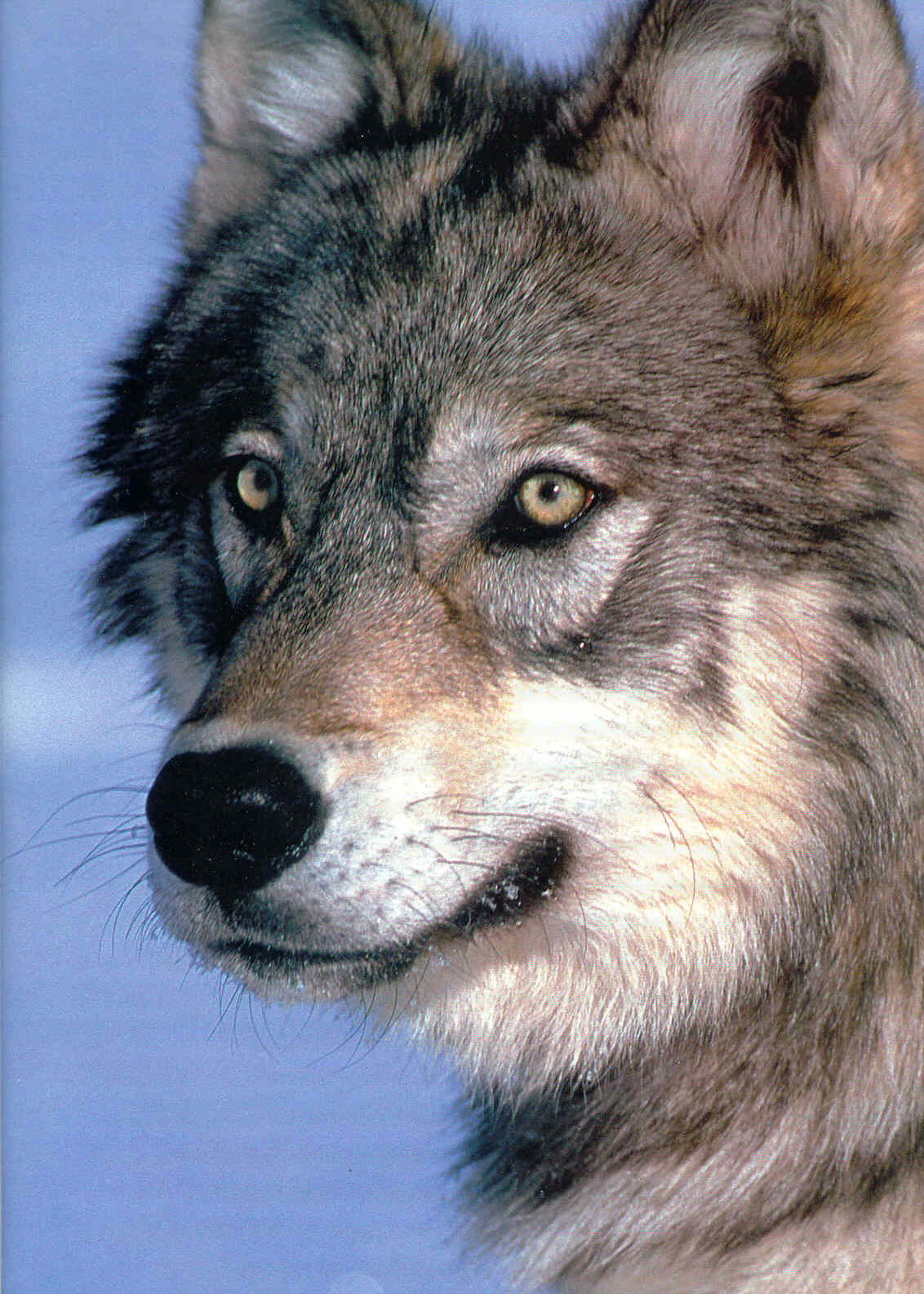 The
Absence of Wolves allowed Coyotes to become the top Predator
The
Absence of Wolves allowed Coyotes to become the top Predator
The absence of a top predator for over 60 years had allowed Coyotes to become so numerous in Yellowstone Park and its surrounding public and private lands (73,000 sq. kms), to throw the entire ecosystem out of whack. A quarter of all gophers, a third of all ground squirrels, and two-thirds of voles ended up in a Coyote's jaws.
Coyotes had packed up and were behaving arrogantly like wolves.
In the mid-1990s, there were more than 80 Coyotes in 12 packs, the densest population ever known. By 1998, this robust population had been reduced to 36 survivors in nine small packs.
Remaining Coyotes have learned to cope with the presence of their larger cousins, and have become scavengers again. In Yellowstone and elsewhere, a Grey Wolf will run down a Coyote and kill it on sight. So these Coyotes have become wary again, and have stabilized as opportunists in a Wolf-dominated world.
Some people claim many of the "wolf-mimicking" Coyotes of Yellowstone fled eastwards adding to the gene pool of the Eastern Coyote/Red Wolf hybrid, although this is rubbish. The first solitary Coyote was spotted in Ontario in 1919, not 1998. The Coyotes that arrived in Ontario, were of the northern 'Canadian' variety (Canis latrans incolatus). The Yellowstone Coyote is prone to be the Mountain Coyote (Canis latrans lestes), a smaller animal. Any later 30 lb. encroaching Coyotes of any sub-species would be chased away by the 60 lb Canis Lycaon hybrid that has taken over as top predator in south-eastern Canada and the north-eastern U.S.
Grey Wolves Thrive in Yellowstone
In 1995, 14 wolves from an area near Hinton, BC, were introduced . The following year, another 17 were introduced from near Fort St. John, BC.
The goal of the program was to establish 10 resident packs of wolves in the park. The population now appears to be leveling off at about 31 packs, with 19 breeding pairs and more than 250 adults.
Due to this historic achievement, the U.S. Fish and Wildlife Service recently pushed Grey Wolves from endangered to merely threatened in most of the contiguous 48 states.
Grey Wolves Bring A Balance Back To Nature
The decrease in Coyotes has caused rodents to increase in numbers, resulting in a corresponding increase in raptors, fox and raccoons. Elk have taken to the steep slopes rather than browse in the valleys where the wolves den. This has allowed Willows and Aspens to rebound around low-lying wetlands and creeks. Subsequently, beavers have made a reappearance. Five teams of scientists from Canada and the U.S. are presently studying the long term effects of the wolf reintroduction. Those who are involved, claim this is the most significant animal reintroduction in North America.
Although the wolves have had an effect on the shrinking northern Elk herd, the lack of rain and scarcity of browsing has been the major factor affecting the Elk. Elk numbers peaked in the However, the Elk are now healthier and tougher than they once were. Several wolves have been found to have been killed by Elk so they are not as helpless a prey as some have claimed. A healthy Elk in its prime will rarely be brought down by a wolf.
Other fauna benefiting from the reintroduction are: Black and Grizzly bears, Otters, Muskrats, Mink and all types of birds, including the numerous 'Wolf' Ravens who continuously follow the wolves to feast on their kills, and all insects that thrive on plant life.
These studies have brought about a new conception of wolves, wherever we have the good fortune to find them..
Special Update On the United States Fish and Wildlife Service Red Wolf Reintroduction Efforts

The
red wolf is one of the world’s most endangered wild canids. Once common
throughout the southeastern United States, red wolf populations were
decimated by the 1960s due to intensive predator control programs and loss
of habitat. A remnant population of red wolves was found along the Gulf
coast of Texas and Louisiana. After being declared an endangered species
in 1973, efforts were initiated to locate and capture as many wild red
wolves as possible. Of the 17 remaining wolves captured by biologists, 14
became the founders of a successful captive breeding program.
Consequently, the United States Fish and Wildlife Service declared red
wolves extinct in the wild in 1980.
By 1987, enough red wolves were bred in captivity to begin a restoration
program on Alligator River National Wildlife Refuge in northeastern North
Carolina. Since then, the experimental population area has expanded to
include three national wildlife refuges, a Department of Defense bombing
range, state-owned lands, and private property, spanning a total of 1.5
million acres.
An estimated 100 red wolves roam the wilds of northeastern North Carolina
and another 150 comprise the captive breeding program, still an essential
element of red wolf recovery. Interbreeding with the coyote (an exotic
species not native to North Carolina) has been recognized as the most
significant and detrimental threat affecting recovery of red wolves in
their native habitat. Currently, adaptive management efforts are making
good progress in reducing the threat of coyotes while building the wild
red wolf population in northeastern North Carolina.
This population is the only pure-bred wild one recognized by the U.S. Fish and Wildlife Service.
(Thanks to U.S. F & W Service and Mark Gelbart)
Maned wolves (Chrysocyon brachyurus)
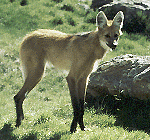 As
some hardy Eucyon ventured across Beringia to the cold steppes of
Siberia and new horizons there, some adventurous southern relatives wandered
into the heat of South America. A far different landscape awaited them,
and they adapted.
As
some hardy Eucyon ventured across Beringia to the cold steppes of
Siberia and new horizons there, some adventurous southern relatives wandered
into the heat of South America. A far different landscape awaited them,
and they adapted.
To be successful in the vast Pampas, with tall grasses, and the many dangers there, their legs grew longer and their ears enlarged so they could hear night sounds to better compete with the Puma and Jaguar for sustenance.
Until recently, many naturalists assumed these
canids were an entirely separate species but, again, dna tests came to the
rescue, and proved they are indeed a sub species of the Red wolf. In their
adopted homeland, they have filled an empty niche, which in Africa is assumed by
the Cape Hunting dog, the Abyssinian Wolf and the Hyena.
The Maned wolf has the head and coloring of a wolf, the large ears of an African hunting dog, and the body of a hyena. Maned wolves are about 3 feet tall shoulder height, and weigh about 50 pounds. Its body is covered with golden-red fur, and it has black legs with a black mane.
Maned wolves live in monogamous pairs, and mate for life. They are solitary like our western Coyotes, and only interact during their brief breeding season which begins in April.
In August and early September mothers give birth to 2-5 Maned wolf pups. In captivity, males help raise pups by regurgitating food. Captive Maned wolves live between 12-15 years.
The Maned wolf lives in the tropical savannah and scrub forests of South America - specifically, northern Argentina, Paraguay, eastern Bolivia, and southeastern Peru.
Maned wolves are omnivorous and nocturnal, preferring to rest under forest cover during the day and hunt until sunrise. They are very shy, and only attack humans when they feel threatened.
It is estimated there are between 2200 - 4500 Maned wolves remaining.
When I first claimed on this web site that Maned wolves were related to Red wolves, I received a few angry denials from some sanctimonious "experts". Well, I guess I have the last laugh now.
It would not surprise me to learn that someday, those responsible for labeling animals with those fancy scientific Latin names, will modify this fellow's label to put him generically alongside his brethren in North America, right where he belongs.
Gr
ey wolves Canis lupusGrey wolves are considerably larger (typical 170 lbs) than are red wolves (typically 60 - 100 lbs), and they come in white, black or grey but have no redness as is so evident in red wolves.
When Europeans began settling eastern North America, they hunted resident
red wolves into extinction in the north-eastern U.S. and in Canada's Atlantic
provinces.
Remnant populations followed deer herds north into south- eastern Ontario and south- western Quebec, or retreated into the swamps of the Carolinas.
The southern population became isolated and its gene pool became minuscule.
However, in the north, Red wolves replaced Grey wolves where the latter were driven into near extinction.
Until recently, Grey wolves were routinely shot by Government hunters even in Algonquin Park.
This genocidal practice allowed invading red wolves a better chance to establish a foothold in Algonquin Park, where they survive in endangered numbers today.
As railways and farming spread westward, the Coyote traveled east to fill in a void left by his larger nemesis.
In 1919, Coyotes were documented in Ontario, hybridized with the Red wolves of eastern Ontario, and eventually crossed the St. Lawrence winter ice-cover south into New York state.
The Americans called them "Coydogs" and eradicated them on sight.
In the relatively protected Algonquin Park region, three separate species of wolf were dna documented.
 * Grey Wolves in northern areas of the
park (Canis Lupus).
* Grey Wolves in northern areas of the
park (Canis Lupus).
* Red Wolves in central areas of the Park (Canis Rufus). (Incl some
hybridization with Grey wolves).
* Hybridized Red Wolf/Coyote populations in the southern and south-east
fringes of the
Park.
By far the most successful of these populations were the latter, successfully combining the craftiness of the Coyote and the larger size of the Red Wolf, they expanding outwards in all directions, with an emphasis towards the east, where pure Grey wolves had been entirely eliminated.
The Grey wolf once inhabited most, if not all, of the Northern Hemisphere. Excluding modern man, the wolf was the most widely distributed land mammal that ever lived.
There were once at least thirty
different subspecies of wolf. Most have become extinct. About five
subspecies survive today. Wolves are able to survive anywhere there is adequate
food and human tolerance.
The Finnish wolf population was hunted down in the 1920's. At present there are
about 200 wolves living in Finland.
In the whole of Russia there are about 30,000 wolves, but
in Karelia, only about 350 individuals.
The North American Eastern Grey Wolf
Canis lupus Lycaon
Eastern Canada’s population of Eastern
Wolves, a sub-species of the Grey Wolf, is primarily found in southeastern Ontario
and
southwestern Quebec. This range includes La Mauricie National Park of Canada.
The Eastern Wolf is fairly small and fawn-coloured, with black on its back and sides, and red-brown behind its ears. In the Mauricie region, male Eastern Wolves stand about 80 cm (32 inches) at the shoulders and weigh around 40 kg (88 lbs), while females measure about 75 cm (30 inches) at the shoulders and weigh approximately 30 kg (66 lbs). It is the smallest subspecies of grey wolf except for the Mexican Wolf.
The Eastern Wolf needs large areas of forest- either deciduous, coniferous, or mixed - to survive. It is a shy mammal, easily disturbed by human presence and activity.
In May 2001, COSEWIC listed the Eastern Wolf as a subspecies of special concern because it is so vulnerable to human activity. Throughout its range, the Brush Wolf (Western Coyote/Red Wolf hybrid), which is approximately the same size, has interbred with it, and it is difficult to tell them apart without resorting to dna testing.
 More Government
sponsored testing is required to enable scientists to obtain a better picture
and appreciation for this endangered species of wolf, and the Brush wolf dna contamination.
More Government
sponsored testing is required to enable scientists to obtain a better picture
and appreciation for this endangered species of wolf, and the Brush wolf dna contamination.
The Eastern Wolf is an important part of La Mauricie National Park’s ecosystem. It feeds on prey like deer and moose, helping keep their populations at sustainable levels. This helps maintain both the diversity and richness of park vegetation, and the ecological integrity of the entire forest ecosystem.
Two wolf packs, with 5 to 10 members each, currently roam the small, 536 km2 national park. Yet their movements often take them beyond the park’s boundaries, where they are no longer protected.
Eastern Wolves often fall victim to trapping, hunting, and road traffic. They are timid and easily disturbed by logging and recreational activities. Critical wolf habitat continues to be lost to agriculture, the timber industry, and urban expansion.
Many people have misguided
perceptions about wolves. Some are afraid of wolves. Others view them as
predators that threaten livestock and wildlife like deer and moose. People
often don’t realize how important wolves are to ecosystem health.
Using information gathered through the research program, Parks Canada is taking steps to ensure the survival of the Eastern Wolf, including:
-
developing a conservation strategy for protecting Wolves inside and outside the park.
-
creating an education program about the importance of wolves to the region’s forest ecosystems, to change perceptions of the wolf.
Status
Hopefully Eastern Wolf populations will stabilize and even grow in and around La Mauricie National Park once the conservation strategy is implemented.
In the meantime, the two wolf packs are still being monitored. Parks Canada is seeking to understand how the wolves use their habitat inside and outside the park, and to determine the long-term impacts of human activity on wolf populations.
Steppe Wolf Canis lupus campestris

Asian Steppe wolves are not protected, and are numerous in Mongolia. They are not white as are many more northerly Siberian wolves. Most Mongolian wolves are the colour of the desert to blend in. They eat almost every animal they can catch. Wolves usually hunt in packs, but sometimes one wolf hunts on its own. A pack of wolves can take down animals much larger and stronger then themselves as moose, deer, horses and bulls. Wolves are very intelligent creatures, maybe the most intelligent animals besides humans.
These
wolves are strictly carnivorous. Wolves do not kill for sport, but for
survival in Mongolia's harsh climate. Wolves hunt just about everything
that will provide a meal for them. Depending on the area in which they
live and the time of season, they hunt everything from large birds to large
mammals to small ones. 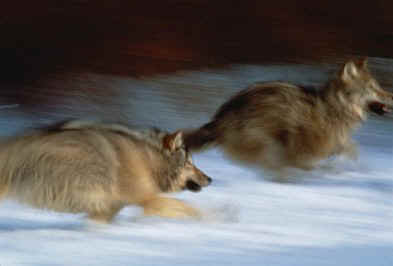
Wolves usually prey upon the sick, weak, and old animals that they come across. It is much easier for them to hunt these animals then it is a full grown healthy one. By killing off the weak animals, wolves help strengthen the herd of which they take their weak prey from.
An old or unhealthy animal can be a burden to its herd. For example, an aged caribou eats food that other caribou need to raise their young. A sick elk could infect other members of the herd. Wolves eliminate such animals performing an important natural function by maintaining the health of their prey species.
Mongolian wolves are liable to hunt domestic animals of nomadic families at any time day or night. They hunt when they are hungry but if they are not successful they can go without food for several weeks.
The pack defends and guards its territory from intruding wolves. Their territory size depends on the availability of prey. If prey is scarce, the territory may cover as much as 800 square miles (2,100 square kilometers). If prey is plentiful, the area may be as small as 30 square miles (77 kilometers). After a successful hunt, the pack will gorge on the kill. They have large stomachs, enabling them to eat 20 pounds (9 kilograms) of meat or more. Wolves can go without food for weeks at a time.
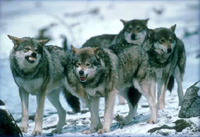 Wolf
pups live on only mother's milk for the first three weeks of their life.
After three weeks they begin to eat meat. The pups' parents bring the
meat to the pups by carrying it in their stomachs. The pups then lick
the mouths of the older wolves to get them to regurgitate the food. The
pups then eat the coughed up food. This goes on until the fall when the
pups begin to hunt with the rest of the pack.
Wolf
pups live on only mother's milk for the first three weeks of their life.
After three weeks they begin to eat meat. The pups' parents bring the
meat to the pups by carrying it in their stomachs. The pups then lick
the mouths of the older wolves to get them to regurgitate the food. The
pups then eat the coughed up food. This goes on until the fall when the
pups begin to hunt with the rest of the pack.
WOLVES
IN MONGOLIA: The habitat of the wolf covers huge territories from the
Western Altai's borders to the Eastern steppes. The population of this
highly-adaptable animal has been stable for years, and in some areas has
increased, causing damage to game and livestock. The largest wolves
found in Mongolia may reach 2 meters (about 7 ft.) from the tip of the nose
to the tip of the tail and weigh up to 100 kg.(220 lbs).
Mexican wolf Canis lupus baileyi

Mexican wolves are the smallest subspecies of North American
Grey wolves.  They are also the most endangered. Commonly referred to as "El lobo,"
the Mexican wolf is grey with light brown fur on its back. Its long legs and
sleek body enable it to run fast.
They are also the most endangered. Commonly referred to as "El lobo,"
the Mexican wolf is grey with light brown fur on its back. Its long legs and
sleek body enable it to run fast.
Height 26-32 inches at the shoulder. Length 4.5-5.5 feet from nose to tip of tail. Weight 60-80 lbs. Males are typically heavier and taller than the females. Lifespan Up to 15 years in captivity.
Diet: Staples Ungulates (large hoofed mammals) like white-tailed deer, mule deer and elk. Also known to eat smaller mammals like rabbits, ground squirrels and mice.
Population: Once extirpated from the southwestern United States, 34 wolves returned to southeastern Arizona following a reintroduction program begun in March, 1998. There are only about 200 Mexican wolves in captivity. The goal of the reintroduction program is to restore at least 100 wolves to the wild by 2008.
 Range:
Mexican wolves once ranged from central Mexico to southwestern Texas,
southern New Mexico and southeastern Arizona. Today, the Mexican wolf has been
reintroduced to the Apache National Forest in southeastern Arizona and may move
into the adjacent Gila National Forest in western New Mexico as the population
expands.
Range:
Mexican wolves once ranged from central Mexico to southwestern Texas,
southern New Mexico and southeastern Arizona. Today, the Mexican wolf has been
reintroduced to the Apache National Forest in southeastern Arizona and may move
into the adjacent Gila National Forest in western New Mexico as the population
expands.
Behavior: Mexican wolves prefer to live in mountain forests, grasslands and shrublands,
and are very social animals. They live in packs, which are complex social
structures that include the breeding adult pair (the alpha male and female) and
their offspring. A hierarchy of dominant and subordinate animals within the pack
help it to work as a unit.
Reproduction: Mating Season Mid February-mid March. Gestation: 63 days. Litter size: 4-7 pups. Pups are born blind and defenseless. The pack cares for the pups until they mature at about 10 months of age.
Missing from the landscape for more than 30 years, the howl of the Mexican Grey wolf can once again be heard in the mountains of the southwestern United States. The Mexican wolf, like many species protected by the U.S. Endangered Species Act, is getting a second chance to play its role in nature through an ambitious recovery program.
Unlike the Brush wolves of eastern Canada, there is no Coyote dna in this wolf. Although similar in size, it is a creature of habit, and is more timid. It is not as brazen and wily as is the Brush wolf. It will kill and displace any coyotes it can catch.
European wolves Canis lupus lupus
The Eurasian Wolf (Canis lupus lupus), also known as the Common Wolf, European Wolf, Carpathian Wolf, Steppe Wolf, Tibetan Wolf and Chinese Wolf is recognized as a subspecies of the Grey wolf (Canis lupus). Originally spread over most of Eurasia, with a southern limit of the Himalayas, the Hindukush, the Koppet Dag, the Caucasus, the Black Sea, and the Alps, and a northern limit between 60° and 70° northern latitude, it has been pushed back from most of western Europe and Eastern China, surviving mostly in Central Asia.
European wolves typically have shorter, denser fur than their North American counterparts. Their size varies according to region, though as a whole, adults stand at 30 inches (76 cms) at the shoulder and weigh around 70-130 lbs (32-59 Kgms), with females usually being about twenty per cent smaller than males. The heaviest known European wolf was killed in Romania, and weighed 158 lbs (72 kilograms). Colour ranges from white, cream, red, grey and black, sometimes with all colors combined. Wolves in central Europe tend to be more reddish coloured than those in Northern Europe indicating the original proto-wolf transient from North America was reddish.
Currently, it has the largest range among any wolf
subspecies and is the most common in Europe and Asia. European wolves, like most all others, live and hunt in packs which
are extended families of an alpha male, his mate, and
their offspring. They usually stay within a home range, but may wander
far outside their territory to hunt. They hunt and kill game up to 10
times heavier than their own weight. Wild reindeer, elk, and red deer
are their favorite prey. European wolves will also eat much smaller
animals such as mice and frogs. Because of the decline in the number of
wild game, they have begun to prey on domestic horses, cattle, and dogs.
Starving wolves will even eat potatoes, fruits, buds, and lichen.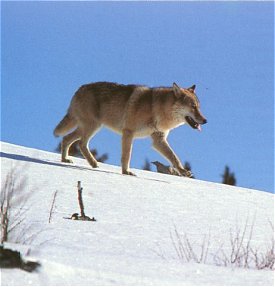
The alpha male and female mate between January and March. The cubs are born seven weeks later in a den dug among bushes or rocks. The male brings food back to the den, either by carrying it whole or by swallowing and then regurgitating it for the others to eat. As the cubs grow, the mother and other members of the pack help to feed them.
To a North American viewer, these wolves have a predominant reddish hue that North American Grey wolves don't have. This could be an inherited coloration caused by their Eucyon ancestry which was maintained by their ancestors' non-hybridization with white Asian wolves.
Few European countries still have substantial numbers of wolves. Wild wolves are hard to count, so exact numbers are not known. Sometimes radio-tracking is used to determine their numbers. European wolves have managed to survive only in the most remote, mountainous, or densely forested regions. Areas in which these wolves can live without coming into conflict with humans are decreasing. There is little effective international agreement about the wolf's conservation. All efforts to preserve the wolf are conducted locally.
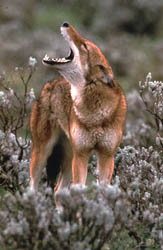 Because of the increasing shortage of natural prey in
Central Europe, some wolves
have been forced to give up their pack-hunting habits, and scavenge for
food around villages and farmhouses. Projects which are financed by the World Wide Fund for Nature may enable
small numbers of wolves to survive if farmers and herdsman can be
persuaded to accept them.
Because of the increasing shortage of natural prey in
Central Europe, some wolves
have been forced to give up their pack-hunting habits, and scavenge for
food around villages and farmhouses. Projects which are financed by the World Wide Fund for Nature may enable
small numbers of wolves to survive if farmers and herdsman can be
persuaded to accept them.
In Norway, wolves are protected to the extent that they are illegal to be killed by anyone other than farmers protecting their livestock. Similar to most Canadian provinces, farmers are often compensated for livestock which is killed by the endangered wolves. Similar to Canada, the wolves often get blamed even though dogs are often the culprits.
"Grupo Lobo" was founded in Spain and Portugal in 1985 in an attempt to protect the wolves in the mountains on the Spain/Portugal border. Only in Spain is the wolf making a determined resurgence. There is an extremely small number of wolves in Sweden, regardless of protective legislation. These systems are often abused. Lapp herdsman in the North of Sweden have often blamed the deaths of their reindeer on wolves rather than on poor care. The "wolf-plague" in Scotland resulted in the extermination of the animal there.
The last British wolf died in 1743. Wolves survived in Ireland until about 1773. Similar waves of wolf persecution on the European continent has driven the few survivors into remote areas far away from human settlement. In Britain, there are some circles that are promoting the reintroduction of wolves into Scotland and parts of rural England and Wales. It appears that most British farmers are against this idea.
Although the wolf is a protected species in most European countries, some hunters see no reason to stop killing wolves for sport, and will pay a great deal of money for the privilege. Wolf survival in Europe obviously requires more than simple legislations. These wolves are rather shy and intelligent, yet they are still viewed as a ruthless predator by the mainstream.

European Wolf/Dog Hybrids
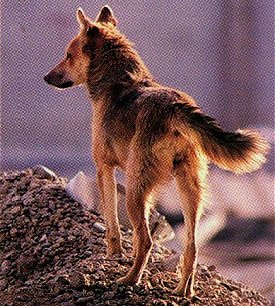
Throughout Europe, these dogs and wolves will occasionally mate, and their offspring are often impossible to distinguish from ordinary dogs.
The wolf-dog's (right) deceptive appearance makes it all that more dangerous. Wolf-dogs may wander freely through populated areas, unrecognized as wolves.
These hybrids are often wilder than their feral parents. They can be extremely ferocious. Europeans are wary of them due to ancient folklore and the possibility of rabies.
The reddish hue of European Wolves is usually striking in these hybrids. North American wolf/dog hybrids are only reddish when they cross with a Red wolf.
Pure strains of Grey wolf in North America do not have any red coloration
Czechoslovakian (CsV) Wolfdog
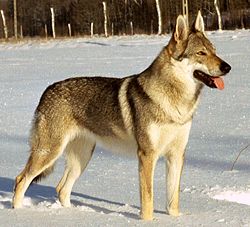
The CsV is a relatively new breed of dog that traces its original lineage to an experiment conducted in 1955 in the former Czechoslovak Soviet Socialist Republic (CSSR). After initially breeding a German Shepherd dog with a Carpathian wolf, a plan was worked out to create a wolf/dog breed that blended the desired qualities of both animals. It was officially recognized as a national breed in the CSSR in 1982. In 1999, it became FCI standard no. 332, group 1, section 1.
Both the build and the hair of the CsV are reminiscent of a wolf. The lowest dewlap height is 65 cm for a dog and 60 for a bitch and there is no upper limit. The body frame is rectangular, ratio of the height to length is 9:10 or less. The expression of the head must indicate the sex. Amber eyes set obliquely and short upright ears of a triangle shape are its characteristic features. The set of teeth is complete (42); very strong; both scissors-shaped and plier-shaped setting of the dentition is acceptable. The spine is straight, strong in movement, with a short loin. The chest is large, flat rather than barrel-shaped. The belly is strong and drawn in. The back is short, slightly sloped, the tail is high set; when freely lowered it reaches the tarsuses. The fore limbs are straight, and narrow set, with the paws slightly turned out, with a long radius and metacarpus. The hind limbs are muscular with a long calf and instep.
The color of the hair is from yellow-grey to silver-grey, with a light mask. The hair is straight, close and very thick. The CsV is a typical tenacious canterer; its movement is light and harmonious, its steps are long.
Temperament:
The Wolfdog is more versatile than
specialized. It is quick, lively, very active, fearless and
courageous. Shyness is a disqualifying fault in CsV competitions.
The CsV develops a very strong social relationship not only with their owner, but with the whole family. It can easily learn to live with other domestic animals which belong to the family; however, difficulties can occur in encounters with strange animals. It is vital to subdue the CsV's passion for hunting when they are puppies in order to avoid aggressive behavior as an adult. The puppy should never be isolated in the kennel; it must get used to different surroundings, for traveling and so on. Female CsVs tend to be more easily controllable and both genders often experience a stormy adolescence.
The CsV is very playful and temperamental. It learns easily. However, it does not train spontaneously, the behavior of the CsV is strictly purposeful - it is necessary to find motivation for training. The most frequent cause of failure is usually the fact that the dog is tired out with long useless repetitions of the same exercise, which results in the loss of motivation.
These dogs have admirable senses and are very good at following trails. They are very independent and can cooperate in the pack with a special purposefulness. If required, they can easily shift their activity to the night hours. Sometimes problems can occur during their training when barking is required. CsVs have a much wider range of means of expressing themselves and barking is unnatural for them; they try to communicate with their masters in other ways. Generally, to teach CsV stable and reliable performance takes a bit more time than does to teach traditional specialized breeds.
Saarloos Wolfhond
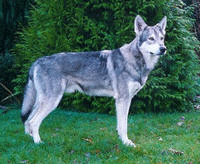
This
breed of dogs derives his name from, Mr. Leendert Saarloos.
Mr. Saarloos strived for a breed of dogs without degenerative symptoms,
and with a natural resistance against all sorts of diseases.
Although Mr Saarloos was interested in genetics, he approached this
mostly from his practical experiences. Before he started to breed
the Wolfdog, he crossed many other animals such as mice, rabbits,
pigeons etc.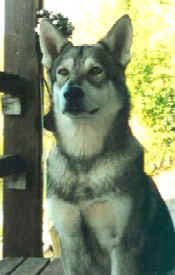
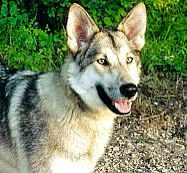 He
chose the wolf as the ancestor of his new breed because it has a lot of
the desired properties he desired.
In the beginning, there
was the German Shepherd male dog, Gerard van Fransenum together with the
female wolf Fleur, which he bought from the Blijdorp zoo. This
couple had 28 puppies from which 3 were good enough to proceed
with. At the advice of a Dutch expert in genetics, Dr. L.
Hagendoorn, the brother and sisters were matched.
He
chose the wolf as the ancestor of his new breed because it has a lot of
the desired properties he desired.
In the beginning, there
was the German Shepherd male dog, Gerard van Fransenum together with the
female wolf Fleur, which he bought from the Blijdorp zoo. This
couple had 28 puppies from which 3 were good enough to proceed
with. At the advice of a Dutch expert in genetics, Dr. L.
Hagendoorn, the brother and sisters were matched.
In
1963 he chose a new female wolf, Fleur II, to counteract
in-breeding. After many disappointments he had a new race, the
"Saarloos Wolfhond".
The
Saarloos Wolfhond is a powerful, wolflike, thick-hairy dog with a
withers height 65-75 cm. for a male, and 60-70 cm. for a female.
The oval bone is powerful but not big. Its structure is harmonious
with tall legs. Males and females are very different in appearance
and airs.
The
Saarloos Wolfhond must exhibit an image of a careful, attentive and
devoted dog that is reserved. It must not be nervous around
strange people and circumstances. It is very cautious, and
exhibits the power of reaction of the wolf with the devotion of the
dog. The primary characteristic of the breed is an
independence of action which is why it is such a great guide dog for the
blind.
Appennine (or) Italian Wolf Canis lupus italicus
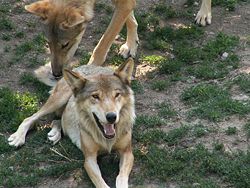 The
Appennine Wolf, is a subspecies of the Grey wolf found in the Appennine Mountains
of Italy, and is also called the Italian wolf. It was first described in
1921, and was recognized as a distinct subspecies in 1999. Recently,
due to an increase in population, the subspecies has also been spotted in areas
of Switzerland and Southern France, particularly in the Parc National du
Mercantour. It is federally protected in all three countries.
The
Appennine Wolf, is a subspecies of the Grey wolf found in the Appennine Mountains
of Italy, and is also called the Italian wolf. It was first described in
1921, and was recognized as a distinct subspecies in 1999. Recently,
due to an increase in population, the subspecies has also been spotted in areas
of Switzerland and Southern France, particularly in the Parc National du
Mercantour. It is federally protected in all three countries.
This is a medium sized subspecies by Grey Wolf standards. Males have an average weight of 24-40 kilograms (53-88 lbs, with females usually being about 10% lighter. Body length is usually 100-140 cm (39-55 inches). Fur colour is commonly blended grey or brown, though black specimens have recently been sighted in the Mugello region and the Tuscan-Emilian Apennines.
 Comparative studies on Italian wolves, Eastern
European wolves and feral dogs, showed that Italy's wolf population was the
purest, and least affected by hybridization with domestic dogs in Europe.
However, in 2004, three wolves were found in the south-central Tuscan province
of Siena, sporting dewclaws on their hind legs, indicating some dog
contamination in the gene pool. Though this has caused concern on the danger
posed to the wolf's genetic purity, some biologists are encouraged by such an
obvious symptom, as it is a potentially useful factor in diagnosing hybrids.
Comparative studies on Italian wolves, Eastern
European wolves and feral dogs, showed that Italy's wolf population was the
purest, and least affected by hybridization with domestic dogs in Europe.
However, in 2004, three wolves were found in the south-central Tuscan province
of Siena, sporting dewclaws on their hind legs, indicating some dog
contamination in the gene pool. Though this has caused concern on the danger
posed to the wolf's genetic purity, some biologists are encouraged by such an
obvious symptom, as it is a potentially useful factor in diagnosing hybrids.
Diet:
The Italian Wolf is a nocturnal hunter which feeds
primarily on medium sized animals such as Chamois, Roe Deer, Red Deer, and Wild
Boar. In the absence of such prey items, its diet will also include
small animals such as hares and rabbits. An Italian wolf can eat up to
1,5-3 kg of meat a day. It will occasionally consume berries and herbs for roughage.
The wolf has adapted well in some urbanized areas and as such, will usually not
ignore refuse or domestic animals.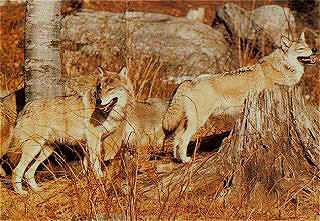
Behaviour and reproduction: Due to a scarcity of large prey, wolf packs in Italy tend to be smaller than average. Packs are usually composed of a reproducing alpha pair and juveniles which remain with their birth family until they're old enough to disperse and produce cubs. However, in areas where large herbivores such as deer have been reintroduced, such as the Abruzz o National Park, packs consisting of 6-7 individuals can be found.
Mating occurs in mid- March with a 63 day gestation period. The number of cubs born is dependant on the mother's age, usually ranging from two to eight cubs. Cubs weigh 250-350 grams at birth and open their eyes at the age of 11-12 days. They are weaned at the age of 35-45 days and are fully able to digest meat at 3-4 months.
History: Until the end of the 19th century, wolf populations were widespread across Italy's mountainous regions. By the dawn of the 20th century, the persecutions began and in a short amount of time, the wolf was wiped out in the alps, Sicily and drastically reduced in the Apennine regions.
After the second world war, the situation worsened and the wolf populations reached a historic minimum in the 1970's. In 1972, Luigi Boitani and Erik Zimen were tasked with leading the first Italian investigation into the wolf's plight. Using an area between the Sibillini and Sila mountains as reference points, the duo concluded that the wolf population was composed of a maximum of 100-110 animals.
Italian population: Starting from the 1970s, political debates began favouring the increase in wolf populations. A new investigation began in the early 1980s, in which it was estimated that there were now approximately 220-240 animals and growing. New estimates in the 1990s revealed that the wolf populations had doubled, with some specimens taking residence in the Alps, a region not inhabited by wolves for nearly a century. Current estimates indicate that there are 500-600 Italian wolves living in the wild. Their population is said to be growing at a rate of 7% annually.
French population: Wolves migrated from Italy to France as recently as 1992. The French wolf population is still no more than 40-50 strong, but the animals have been blamed for the deaths of nearly 2,200 sheep in 2003, up from fewer than 200 in 1994. Controversy also arose when in 2001, a shepherd living on the edge of the Mercantour National Park survived a mauling by three wolves. Under the Berne Convention wolves are listed as an endangered species and killing them is illegal. Official culls are permitted to protect farm animals so long as there is no threat to the species.
In northern Spain, a lone wolf was recently DNA tested, and it was determined it was of Italian origin. So the Italian wolf has traveled from the Italian Apennines to the Spanish Pyrenees.
Iberian wolf Canis lupus signatus
Spain is one of the last remaining refuges of the European
wolf. The Iberian wolf population is slowly recovering from its 1970 low
of 400-500 odd individuals with current (2003) figures estimated at as many as
2,000-2,500, almost 30% of European wolf numbers outside Russia. There are
several reasons for the rise in the wolf population . 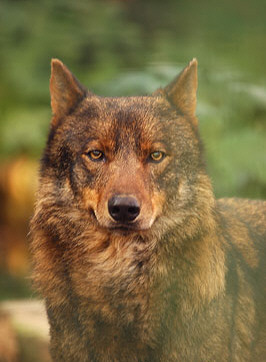
The Iberian wolf is distinguished by its overall redness, and the black marks along its tail, back, jowls and front legs, and so sigantus meaning marked. More than 50 % are found in Northern Castilla y León (1000-1.500 individuals), and less than 35% in Galicia (500-700), with the densest population in North-eastern Zamora (5-7 wolves/100km2).
Though wolves were once present throughout the Peninsula, they are now confined to the North-east, and a few residual populations in the Sierra Morena (Jaén and Cuenca). Recently, however they have managed to cross back over the modern-day barrier of the river Duero and begun to spread southwards and eastwards: two packs have been detected around Guadalajara and have started to move into Teruel in southern Aragon, much to the amazement and trepidation (and at first disbelief) of the locals.
There are thought to be some 300 breeding pairs in Spain, giving a total number of around 1,500 at the start of spring and around 2,000 by mid autumn (1988 figures see below). The wolf in Spain is no longer considered endangered, merely vulnerable, though the Sierra Morena and Extremaduran populations are classified as critically endangered, and the latter is almost certainly extinct. Wolves in the Sierra Morena inhabit private game estates where they are illegally persecuted as they come into conflict with the hunting practices of the rich. Across the border in Portugal, there are reckoned to be between 46 and 62 packs.
Reasons for the recent increase in the Iberian
wolf population: Until the early 1970s, the wolf was
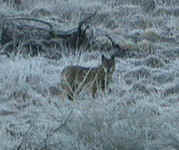 ‘officially'
considered as a pest in Spain, and the government paid out bounties for dead
wolves and distributed strychnine to landowners and peasants. At the time,
many saw the wolf as a mark of a Third World country, in contrast to
‘civilized' nations like France and Britain who had successfully eradicated
their wolf plagues. On occasions in the past, persecution was widespread
and crushing. An act passed by Principality of Asturias details that
between March and December 1816, bounties were paid out for the death of 76
adult and 414 young wolves.
‘officially'
considered as a pest in Spain, and the government paid out bounties for dead
wolves and distributed strychnine to landowners and peasants. At the time,
many saw the wolf as a mark of a Third World country, in contrast to
‘civilized' nations like France and Britain who had successfully eradicated
their wolf plagues. On occasions in the past, persecution was widespread
and crushing. An act passed by Principality of Asturias details that
between March and December 1816, bounties were paid out for the death of 76
adult and 414 young wolves.
The historian Juan Pablo Torrente concluded
that the hunting of wild beasts, including wolves, bears and foxes represented,
‘in absolute and relative terms, a considerable source of wealth' for local
populations. The lobero or wolf-hunter was a respected county figure until
relatively recently, and a whole range of ingenious traps have been devised over
the centuries to catch wolves. All are now illegal. It is however
still legal to hunt wolves in most of Spain. In most of its range, the Law
states that the species must be respected as long as it does not come into
conflict with human interests.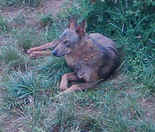
While hunting itself does not necessarily pose a big threat for the Iberian wolf, as most hunts end in failure, the Law gives carte blanche for indiscriminate hunting in most areas. North of the River Duero, only the municipality of Muelas de los Caballeros in north of Zamora, where the densest Spanish wolf populations are found, has shown any real interest for its conservation. Protection is, however, much stronger south of the Duero where the Iberian wolf populations are far more fragile.
Secondly, in the last 40 years, there has
been a huge migration of people from the country to the towns. This depopulation
has led to the regeneration of natural vegetation in former agricultural areas
and the huge increase in prey species such as roe deer and boar. Just drive or
take a train across central and northern Spain and you will appreciate the
immensity and emptiness of the landscape, and it potential to support rich and
varied fauna.
Thirdly, people's attitudes have changed. While there is still much
suspicion, when not outright hate, among some rural populations, many in Spain
now see the wolf as an animal worthy of protection. That great Spanish
populist of nature, Félix Rodríguez de la Fuente,
played no small part in this conversion. Millions of homes in Spain in the
nineteen-seventies were captivated by his television series, ‘El Hombre y la
Tierra', of which the wolf was the star of the show. Rodríquez used
wolves he had raised himself from cubs living in a semi-wild fenced estate for
the film. But, for all its trickery, the episodes on el lobo still stand
out as superb and beautiful piece of nature documentary, and holds a rightful
place in contemporary Spanish culture.
Arabian wolf Canis lupus arabs
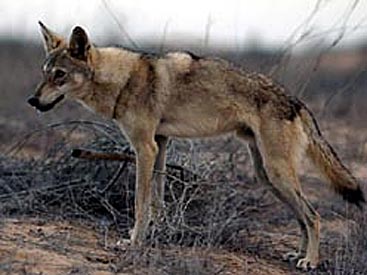
The Arabian wolf is a subspecies of
the Grey wolf which was once found throughout the Arabian Peninsula, but
now only lives in small pockets in Oman, Yemen, Jordan, Saudi Arabia,
and probably in some parts of the Sinai Peninsula of Egypt.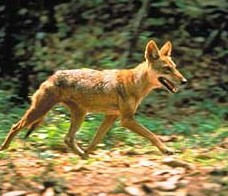 In Isreal, there are between 100 and 150 Arabian wolves all over the
Negev and the Ha'arava.
In Isreal, there are between 100 and 150 Arabian wolves all over the
Negev and the Ha'arava.
Standing approximately 26 inches shoulder height and weighing an average of 40 pounds, the Arabian Wolf is the smallest wolf subspecies, yet, the largest canid in Arabia. They have short greyish-beige hair which becomes much longer and thicker in winter. Their ears are proportionately larger in relation to body size when compared to other species, an adaptation needed to disperse body heat.
Also, Arabian wolves do not live in large packs, and instead hunt in pairs or in groups of about three to four animals. This subspecies is unusual, as it is not known to howl. Arabian wolves are unique among grey wolves due to the middle two toes of their paws being fused, a trait originally thought unique to the African Hunting Dog.
I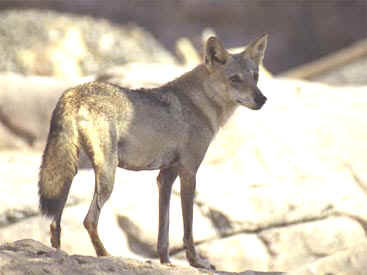 t will kill animals up to the size of a goat, but
usually feeds on carrion, small birds, rodents, reptiles and insects. It
also eats fruits and plants when meat is scarce. They dig burrows
in the sand to protect themselves from the sun, and hunt mainly at
night.
t will kill animals up to the size of a goat, but
usually feeds on carrion, small birds, rodents, reptiles and insects. It
also eats fruits and plants when meat is scarce. They dig burrows
in the sand to protect themselves from the sun, and hunt mainly at
night.
The only time that Arabian wolves are known to be territorial is when their pups are born. The litter size can be as large as 12, but is usually only 2 or 3. They are blind at birth and weaned at about eight weeks when the parents regurgitate food for them.
Their ears are large in comparison to the rest of it's body (similar to the Maned wolf. Their eyes are naturally yellow with black pupils. However, many are found with brown eyes, revealing that somewhere down the line their ancestors interbred with feral dogs.
It will kill animals up to the size of a goat, but usually feeds on carrion, small birds, rodents, reptiles and insects. It also eats fruits and plants when meat is scarce. They dig burrows in the sand to protect themselves from the sun, and hunt mainly at night.
Current status: In Oman, the wolf population has increased significantly since hunting was banned, and there is a strong possibility that they will naturally reestablish themselves in certain places within the region in the relatively near term.
Abyssinian
(or Ethiopian) wolf Lupus simensis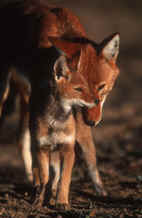
Rodents account for more than 90% of its prey. The giant mole rat is the main food item; other prey includes grass rats and hares. The Ethiopian wolf is mostly diurnal, but becomes nocturnal in areas where it is persecuted. Dens usually consist of a system of burrows beneath a rock overhang or cliffs. Caching prey and scavenged material in shallow holes is common.
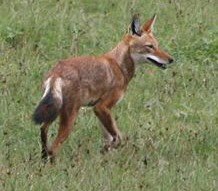
A typical pack is an extended family group formed by all males born into
the pack during consecutive years and 1 - 2 females. All pack members
participate in the defense and marking of their territory, and parents and
sub-adult helpers contribute to the rearing of pups.
DNA tests have absolutely proven that Ethiopian wolves are
directly descended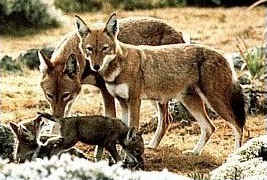 from the larger North American Red wolf, although they have
altered to fit their North African habitat. They still exhibit their
ancestors' preference for cool mountainous regions but they have lost
their long hair, and have shrunk to the size of a coyote, and they
exhibit many Coyote characteristics.
from the larger North American Red wolf, although they have
altered to fit their North African habitat. They still exhibit their
ancestors' preference for cool mountainous regions but they have lost
their long hair, and have shrunk to the size of a coyote, and they
exhibit many Coyote characteristics.
The Ethiopian wolf is unique to Ethiopia. It was reported from most provinces of the country in the 19th century. By the 1970's it had declined considerably. The Ethiopian wolf currently is confined to seven isolated subpopulations in different mountain ranges of the Ethiopian highlands.
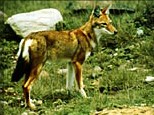

Sixty percent of all land above 3,200 m (10,000') although marginal, has been converted into farmland, and all Ethiopian wolf populations below 3,700 metres (12,000') are particularly vulnerable to further habitat loss.
Habitat loss is exacerbated by overgrazing of highland pastures by domestic livestock, and in some areas habitat is threatened by proposed development of commercial sheep farms and roads. Hybridization of the Ethiopian wolf with domestic dogs could threaten the genetic integrity of the Ethiopian wolf population, but that phenomenon is currently confined to one valley in western Bale.
Indian
wolf Canis lupus pallipes or Canis indica The Indian Wolf has a very short, dense coat that is typically reddish, tawny, or buff coloured. It reaches 60-95 centimetres in height, and typically weighs 18-27 kilograms (40 - 60 lbs. Breeding generally occurs in October, after the rains – early compared to the Grey Wolf.The Indian Wolf is adapted for life in the semi-arid and hot
areas that they typically inhabit. Its relatively small size allows it to
survive on the smaller ungulates, rabbits, hares, and rodents that roam its
territory. The Indian Wolf is a prime example of the Canid's adaptability as a
species, given that its cousins can be found in areas starkly contrasted to the
scrubland, grassland, and semi-arid pastoral environments that the Indian Wolf
thrives in.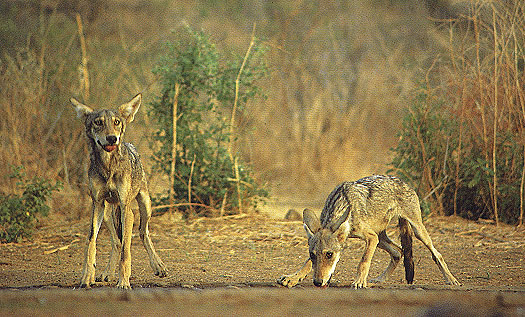
Though the Indian Wolf and the Indian Wild Dog have been portrayed as mortal enemies by author Rudyard Kipling in his book, Red Dog, studies have shown that there is very little competition between the two species where they share common ground. The fact that the wolf inhabits open spaces and feeds primarily on rodents as a contrast to the dog's habit of living in dense forests and hunting medium sized ungulates is enough to ensure peaceful coexistence.
It is a semi-desert-adapted Canid that is exclusive to the eastern Indian subcontinent. A study released in 2004 estimates that there are around 2000-3000 Indian Wolves. Mitochondrial dna tests have ascertained these wolves have an undisturbed lineage of about 400,000 years. making them the second oldest undisturbed wolf population in the world.
Lately, research of the DNA of the Indian Wolf, formerly known as Canis lupus pallipes, supports the suggestion to treat the Indian wolf as a new species of canid (Canis indica). Probably, the Indian wolf migrated to India about 400 thousand years ago, during the Pleistocene and separated from its common wolf ancestors. But other Indian wolves not from India but from the Arabian peninsula, Afghanistan, and Pakistan should be called the south-east Asia wolf (Canis lupus pallipes).
The Indian wolf is the most likely direct ancestor of the Australian Dingo. DNA tests have yet to confirm this.
New Guinea Singing Dog Canis lupus hallstromi
The New Guinea Singing Dog (Canis lupus hallstromi),
known as NGSD, New Guinea Highland Dog, or Singer, is classified as a subspecies
of Grey wolf,
similar in appearance to the domestic dog, related to the Australian Dingo that
is native to New Guinea. Some scientists consider it a separate species of
Canid. Singers have remained isolated from other dogs for almost 6000
years, making them possibly the oldest of the pariah dogs.
Once thought to inhabit the entire island of New Guinea, today wild populations are thought to be extinct, with captive specimens numbering from 100 to 200. They are exceptionally intelligent, but hard to keep because of wild behavioural traits. There is some debate as to whether Singers are truly domesticated animals, though with proper training, their pack-instincts may allow them to live with humans. They are a recognized breed by such organizations as the United Kennel Club, which classifies them as a pariah dog. They are unique in their ability to howl in a wolf-like manner, but unlike wolves, Singers modulate the pitch, hence the name.
Physical description: They have a fox-like appearance, with a double coat that ranges in color from red to brown, and have a characteristically large carnassial tooth. They stand between 14 and 18 inches (36 to 46 cm) at the shoulders, and weigh 17 to 30 lbs (8 to 14 kg) as adults.
They have proportionately short legs and large heads compared to other Canids. They are shorter in height at the withers than are dingoes and Arabian wolves. Their skulls are slightly wider than a dingo's and a Golden jackal's.
Australian Dingo
Canis lupus dingo
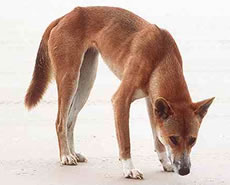
The Dingo is Australia's wild dog. It is found in Australia, in all states except Tasmania. They are found throughout the mainland of Australia, close to a source of water. The Dingo is a medium sized dog, with a bushy tail, and red to yellow coat. Dingos do not bark, but they do howl. It is not a native animal to Australia, and it is unsure exactly how it arrived on our land, but the current theories are; they may be related to wild dogs in South East Asia, they were brought to Australia 15,000 years ago for trade by sea-farers.
DNA tests recently confirmed Australian aborigines traveled from southern Africa to Australia through southern India. Did they bring their dogs from Africa or did they pick them up somewhere on their way? I am sure that DNA testing will soon confirm where these dogs actually originated. If scientists can locate a match for Australian Aborigines in southern India, surely they can do the same for the Dingo.
Dingos are meat eaters, and try to feed mainly on this. If unavailable, they have been known to eat reptiles, and any meaty food source it can find. When food is scarce, they group together to feed on larger animals such as kangaroos. Dingos usually stay and hunt in family groups. Dingos mate once a year, and the female dingo gives birth to up to eight puppies. The puppies are nursed for two months. After the pups are about four months old, they then begin hunting small game such as rabbits.
Amazing Fact: When the puppies are two months old, the mother then regurgitates food for the pups for another two months.
Tibetan (or Himalayan)
wolf Canis lupus lanigerNew DNA testing has indicated this is the oldest Grey wolf subspecies on the planet.
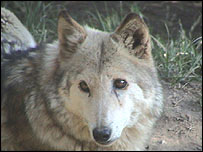
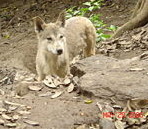
The habitat of the Himalayan Wolf (also known as the Tibetan Wolf) is confined to small pockets of India, Kashmir, and into China and Mongolia. It is believed that when this species first evolved, they were surrounded by glaciers and other physical barriers that did not promote expansion and perpetuation. Much of their habitat is shared by another newly discovered species, the Indian Wolf. It is unknown as to why these two species do not interbreed in spite of the overlap in habitat. This fact allows the two species to remain genetically distinct from all other wolves and dogs found on the planet.
While the Grey wolf is found throughout Siberia, Manchuria, Tibet and the Himalayan regions of Indian, Nepal and Bhutan, and are large dark coloured wolves, the wolves in the western areas of the Himalayas are white. This 'Tibetan' wolf is only found in the Himalayas in cold deserts or mountainous areas.
Up until recently it was believed that all wolves and dogs were part of the wolf-dog clade meaning that all domesticated dogs are derived from wolves. When the Himalayan lineage was studied, it was found this wolf shared no genetic markers with gray wolves or dogs. This indicates that the Himalayan wolf played no role in the domestication of dogs.
The mitochondrial clock, which is based on the rate of changes observed in the DNA sequences, dates this lineage to about 800,000 years. When the divergence of the Himalayan wolf occurred, the habitat of modern day Nepal was going through major geologic and climate upheaval. The Himalayan region, also home to the Indian wolf and the Grey wolf, is the only geographical location in the entire world where these three species of wolves cohabit, thereby supporting a theory that the Indian region is the most likely location for modern wolf hybridization and evolution. All indications point to the Himalayan wolf being one participant in the evolution of Grey wolves, or is this non-diversity actually a product of in-breeding due to there being such a small gene pool available to that particular enclave.
Indian researchers recently compared over 700 DNA sequences of wolves and dogs from all over the world with Indian wolves and dogs. By analyzing DNA from the cell's "power units" called mitochondria, scientists were able to put a time to the point at which the wolf lineage originated. This was possible because mitochondrial DNA changes regularly over time, allowing the emergence of patterns in its sequence to be clocked.
"Until this finding, the peninsular wolf (Canis lupus Indica) [found in the Indian plains] was thought to be the oldest undisturbed lineage of wolf in the world at 400,000 years. We are preparing to further study the species and prepare a project to ascertain the status of the Himalayan wolf so that a conservation breeding plan can be started."
Other tests on wolves from surrounding areas show
they all belong to a very
ancient and genetically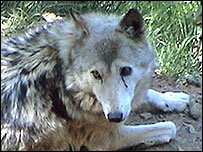 divergent Himalayan lineage.
Julie, the female wolf whose DNA was analyzed,
was found 14 years ago in the high and dry Spiti valley bordering Tibet.
divergent Himalayan lineage.
Julie, the female wolf whose DNA was analyzed,
was found 14 years ago in the high and dry Spiti valley bordering Tibet.
Wildlife authorities have recently spotted 33 Himalayan wolves in the Spiti valley. But Julie is the only one in captivity. Poaching and loss of habitat have sharply reduced the Himalayan wolf population. According to one estimate, there could be as few as 350 left in the entire western Himalayan region.
The conundrum here is how could modern wolves have evolved in North America, migrated to Eurasia, returned to North America, and left its oldest uninterrupted lineage stock isolated deep in the Himalayan Mountains. The only plausible explanation is; the original transient North American proto-wolves, spread throughout Eurasia, seeking out good hunting areas, and became specialized in certain unique areas. The group that colonized the unique Himalayan area maintained their genetic purity for 800,000 years ago, and did not hybridize with any other canids afterwards.
A divergence of any carnivorous population from its ancestral type may be caused by such factors as its prey species, size differences, breeding habits, geographic isolation, climate, climate change and/or hybridization.
Each population acclimatized to better fit its adopted homeland. All scientist agree the Grey wolves that returned to North America were of a newer "improved" variety. Every naturalist understands the natural evolution of prey and predator is intrinsically entwined.
For this scenario to have played out, a land bridge must have been available for North American proto-wolves to pass into Asia before 800,000 years ago. The Pleistocene epoch on the geologic timescale is the period from 1,808,000 to 11,550 years ago, meaning animals had an intermittent land bridge to cross back and forth between Asia and North America during that period. Most Climatologists agree we are still in this epoch, and it is only a matter of time before we are dragged into a new ice age.
Our past conjecture has often been proven wrong by DNA testing, and that will continue into the future. It is known for certain that the Canids have been, and still are very adaptable, and they are still changing to meet new demands and opportunities. Look at the hundreds of dog varieties to illustrate that, from Chihuahuas to Saint Bernards. Given their own devices, wild canids can and have adapted, and have changed to fit new demands. All Scientists agree that Canids successfully spread over more of the world than any other animal - until humans became powerful enough to diminish their numbers.
DNA tests have
also concluded the Black-backed Jackal of Africa is the oldest species of all
living Canids. On the other hand, fossil remains prove the Canidae family began
in North America. One thing is certain, much
of our knowledge of Canids has yet to be learned.
Golden Jackal
Canis aureus
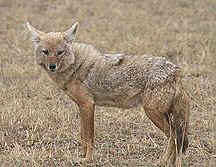
Surprisingly, although often grouped with the other jackals (the
Black-backed Jackal, and the Side-stripped Jackal), genetic research indicates
that the Golden Jackal is not closely related to either of them, but is within the true
"wolf" group which also includes the Grey wolf, the Red wolf and the Coyote.
The genetic evidence is consistent with the form of the skull, which also bears
more similarities to those of the Coyote and the Grey Wolf than to those of
other jackal species.
The range of the Golden Jackal can be seen at left.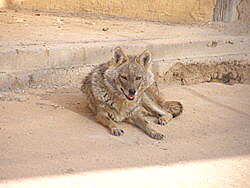
The golden Jackal's short, coarse fur is usually yellow to pale gold and brown-tipped, though the color can vary with season and region. On the Serengeti Plain in Northern Tanzania for example, the Golden Jackal's fur is brown-grizzled yellow in the wet season (December-January), changing to pale gold in the dry season (September-October). Jackals living in mountainous regions may have a greyer shade of fur.
The Golden Jackal is generally 70–105 cms. (28–42 in.) in length, with a tail length of about 25 centimetres (10 in). Its standing height is approximately 38–50 cm (16–20 in) at the shoulder. Average weight is 7–15 kilograms (15–33 lbs) with males tending to be 15% heavier than the females. Scent glands are present on the face and the anus and genital regions. Females have 4-8 teats. They have 42 teeth.
In all their ranges, the Golden Jackal displays a great deal of diversity in appearance. Jackals living in north Africa tend to be larger and have longer carnassials than those living in the Middle East. Moroccan Golden Jackals are paler and have more pointed snouts than Egyptian Golden Jackals.
The Sulimov Dog (not yet registered with the FCI)
The Sulimov Dog is a Russian hybrid
originating from an initial cross between a Siberian Husky and a Golden
Jackal.
The breed was introduced by Klim Sulimov, the chief breeder for Aeroflot airline
security. The primary use of this breed has been to aid in airport
security as sniffer dogs.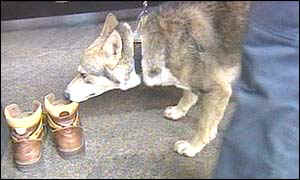
Quoting Sulimov, "My dogs combine the qualities of Arctic reindeer herding dogs, which can work in temperatures as low as -70C, and jackals which enjoy the heat up to +40C. They're perfect for our country.
During the breeding process male Jackal pups had to be fostered on a Husky bitch in order to imprint the Jackals on dogs. Female Jackals accepted male Huskies more easily. The half-bred Jackal-Dogs were hard to train and were bred back to Huskies to produce quarter-bred hybrids (quadroons) which were more easily trained.
These hybrids were small, agile, trainable and had excellent noses. They were then called Sulimov Dogs after their creator, and may one day be registered as a working breed of dog.
Twenty-five Sulimov dogs are used by Aeroflot at Sheremetyevo Airport in Moscow, for functions which include bomb-sniffing. Their breeding program dates back to 1975, but was not applied to bomb detection until 2002.
Canadian Wolf/Coyote Hybrid
Canis Lycaon
(Natural derivative of
Canis rufus and Canis
latrans)
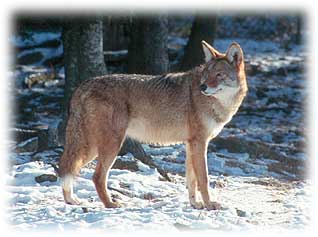
The so-called "Eastern wolf (or) Algonquin' wolf" (largely restricted to the southern area of Algonquin Park and surrounding areas) was originally given a unique species name; "Canis Lycaon." When John and Mary Theberge successfully determined the real identity of those wolves after 11 years of study, and by exhaustive DNA testing, this name became superfluous. DNA testing + skull measurements proved they were, in fact, a previously unknown but almost exact northern race of the Red Wolf (Canis rufus).
Meanwhile, It was recorded that Coyotes were hybridizing with these wolves, and their progeny, called 'Brush wolves' in eastern Ontario, were expanding their range eastwards into the Maritime provinces of Canada, and westwards to the Niagara Region. As they spread throughout Canada's eastern provinces and into the American Northeast, it became evident they were behaving more like wolves than coyotes. (e.g. I have seen evidence that a pack has attacked a healthy herd of deer within walking distance of my home).
Due to their own devices, this new population of wolves is now well established in all four Atlantic provinces. Their weights have been officially recorded as 50 - 60 lbs. They won't go away so it stands to reason, within time, they will inherit the name - Canis Lycaon (or some other).
This lucky new wolf has taken advantage of a recent socio-economic phenomenon in eastern Canada. Since the end of the Second World War, there has been an unprecedented migration of people from the country to large cities. This rural depopulation has led to the regeneration of natural vegetation in former agricultural areas, and to a huge increase in prey species such as White tail deer, rabbits, Canada geese, beaver, and ground hogs (hoary marmots).
Before the 1990s, DNA tests had conclusively proved there were no Grey wolf genes in these hybrids. However, since the 1990s, thanks to the Ontario Ministry of Natural Resources (MNR), Grey wolf dna has been confirmed to be present in varying degrees from 100% to 25% in alpha males of several packs. I have seen a solitary wolf that was as large as a Malamute Husky (well over 150 lbs) chasing a herd of sheep carrying his tail up in the air as only a wolf does. That was from my kitchen window, and he was no Coyote!
More commonly, I have seen 50 to 60 pound Brush wolves playing in the snow from that same window.
The evolution of eastern wolves in Algonquin Park has been a result of changes in the ecosystem brought about by human impact. It is a natural reaction by a top end predator to changing circumstances.
Brush wolves are now well established in Prince
Edward Island and have been observed by professional naturalists to be double
the size of western Coyotes, have a much more variable coloration, and have been
scientifically determined through dna tests at Trent University in Peterborough to contain wolf genes. Government experts
have estimated there are about 1000 Brush wolves well established on the Island but
some people have insisted there are probably four times that many.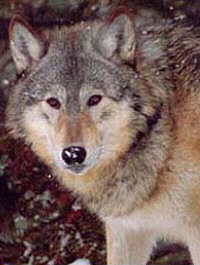
Reports of "Coydogs" in the US north east, and the factual evidence of Coyote/Red Wolf hybridization in the isolated south eastern US range of the Red Wolf have met with derision by farmers, hunters and even many naturalists who considered these crosses to be unnatural (not so in Canada). Products of these unions in the United States were methodically annihilated by Governments "to save the pure strains of Red Wolf". Meanwhile, many naturalists have lately considered the "Texan sub-species" of "Red wolf" to actually be a completely hybridized Coyote/Red wolf population.
However, in eastern Canada, where the Red Wolf was not supposed to be, no such excuse was apparent other than the desire to eradicate a new threat to sheep and cattle.
These new brands of Coyote/Wolf hybrids have retained the shrewdness of the Coyote and have also retained the pack system of its Wolf ancestry. This combination has allowed these animals to: corner large dogs and kill them, bring down 800 lb steers, and frequently prey on other farm animals, where pure wolves would not dare.
I have seen the standard western Coyotes in western Ontario, and also the ones here in eastern Ontario. The ones here are larger, and have a more luxuriant coat than those further west, and vary in colour from the standard coyote grey, no doubt due to the various wolf input. Some people insist our Brush wolves are part dog, and there have been recorded crosses. However, it stands to reason, after millions of years of natural selection aimed at survival of the species, no Brush wolf (or Coyote) in its right mind would prefer a spoiled dog with its dull wits, fat body, and shorter teeth to an efficient killing machine like a Red or Grey wolf.
I have witnessed traditional Coyotes yelping almost every night from my home, as the local pack south of my home assembles for the night's hunt but I have also heard on rare occasions, a solitary unique lower pitch howl which is not typical of the western Coyote, from another pack situated north of my farm. The howl is only made once or twice and then the animal is gone. It could only be the call of a much larger animal. This was definitely not a pack-gathering howl but appeared to be that of a lone defiant animal who was letting me and my huskies know he was here, and this was his territory.
Some people engage in hunting Brush wolves in Eastern Ontario for sport. They claim to see all sizes and all colours here. Their bounties were removed due to popular condemnation.
Brush Wolf Pack Territory Size In Eastern Ontario
While research has determined the typical Brush wolf pack territory is about 50 square kilometers (a radius of 7 kms), in Lanark County, a number of local factors have contributed to reducing the territories of our Brush wolves considerably, creating an ideal breeding ground for the new super Coyote.
Abundant abandoned farms have produced vacant fields, isolated apple orchards and mixed forests that are ideal habitat for White tail deer, the largest prey animal for brush wolves (apart from domestic beef).
Lanark County has the highest population of white tail deer of any county of similar size and terrain in Ontario. The provincial government has outlawed the use of poisons. The province has instituted a municipally run program of reimbursing farmers for wolf/coyote kills. There is no bounty on coyotes, nor brush wolves, nor of any wolves.
The only legal way a farmer can kill a predator in Canada is to catch it killing his livestock. Then, there will be a report, and the Police/MNR officials will undoubtedly launch an investigation into the farmer and whether his firearms are legally registered with the Canadian Firearms Centre (CFC).
Many rural Canadians have elected not to register their firearms, as a key component in that registration is to forego a constitutional right against unwarranted police search, and so, to forestall an automatic 2 years detention, many farmers will not admit they actually shoot at brush wolves - or own firearms.
E.g. In south-western Montague, there are at least three brush wolf packs. This is an area that incorporates about 100 square kms, (about half that of the standard pack elsewhere). I have called them by their geographic locations in south-west Montague Township: the Rideau Regional pack (to my south-west), the Riverside pack (to my south-east), and the Long Branch pack (to my north).
There are also, several lone wolves in this vicinity. Their solitary tracks can easily be seen during winter months.
The necessity for a healthy wolf/coyote population in eastern Canada and the northern U.S. is self evident. It is time that 'Canis Lycaon' is recognized by all Governments and scientific establishments as a useful part of our ecosystem. That has already happened in the Maritimes.
A foot-note: In this area, there is a pack of wolf/coyotes with some individuals so large that hounds sent after them, return with their tails between their legs, if they return at all. Evidently, these fellows refuse to be chased. There is a large black which I have seen that appears to be anything but a coyote.
It occasionally passes through a friend's property and a few years ago, during mating season, attacked my friend's full grown male German Shepherd, and emasculated him, otherwise he was untouched. The owner paid $1,000.00 to repair the damage to his dog. Obviously this brush wolf left a message with the dog and its owner. Now that is some Coyote!
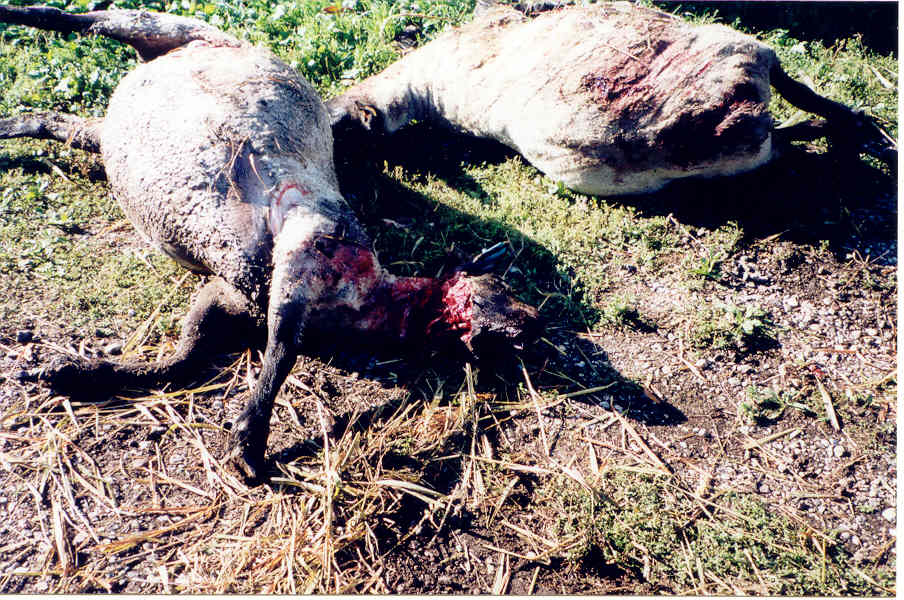
The two sheep above were killed by a pack of eastern Wolf/Coyotes (Brush
wolves). They were
interrupted by the owner, who drove them off before consuming their prey. This
situation has become common here.
I have talked with a hunter near here, who told me a "Wolf" killed his male beagle when he got too close to her den. She shook him until his neck broke. Now, that is one heck of a Coyote! Around here, few people call them Coyotes!
My son, Bill, found signs one winter near here where a pack set upon a herd of deer and killed a large buck. The signs of the struggle were spread over a kilometer.
So, local Coyote/Wolf hybrids have proven wildlife experts were wrong when they claimed they will not attack a healthy deer herd.
TWO SOLITUDES - Brush wolves versus Huskies
The 8 photos below were taken on 24 Jan 2008, less than a kilometer apart just out of eyesight of each other. During the day, they maintain their separate worlds but at night they howl at each other in their mutual hatred (perhaps because they are different). I have watched each play with their own kind in the snow, be affectionate with their own, and both eagerly watch my goats. However, to date, the wolves only go after the carcasses. On the other hand, the dogs go after the smallest of the live animals.
The four photos on the left were taken with an infra-red-sensor digital "trail" camera of a wild Brush wolf. The four photos on the right were taken with a Sony digital camera of "Karghan", a registered Siberian Husky. Both were eating meat.
One was designed by nature for survival. The other was designed by man to pull his sleds. The Brush wolf is free and fends for itself, and controls its own destiny, while the Husky is kept in an enclosure and depends on man for hand outs. One began its journey in the prairie provinces of Canada, ventured east along the railways, hybridized with the northern Red wolf, and spread its range to Newfoundland, on the shores of the North Atlantic.
It has never been eradicated by man in any of its ranges. The other is entirely at the mercy of man. They are both healthy and weigh about 60 lbs. I have never lost a goat to a Brush wolf but I have lost a goat to one of my own Huskies. Which is smarter? Which can survive on its own?
Which would you rather be?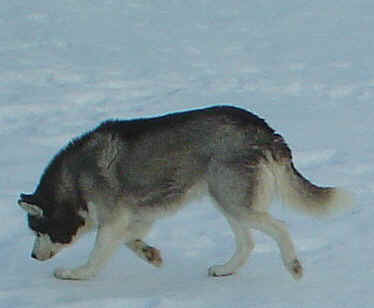
|
|
|
|
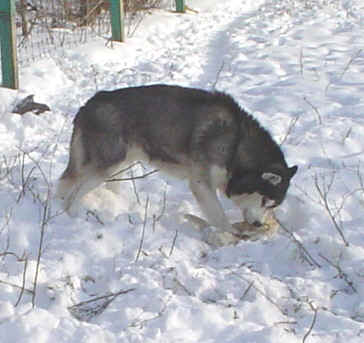
|
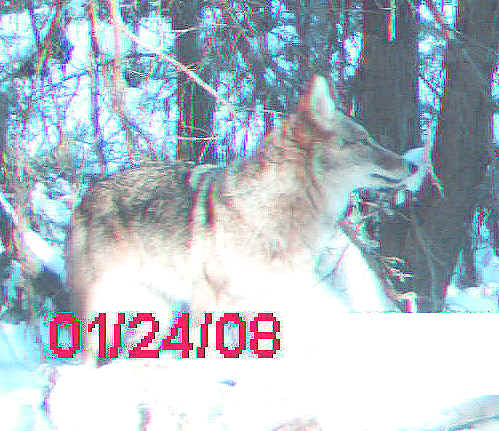 |
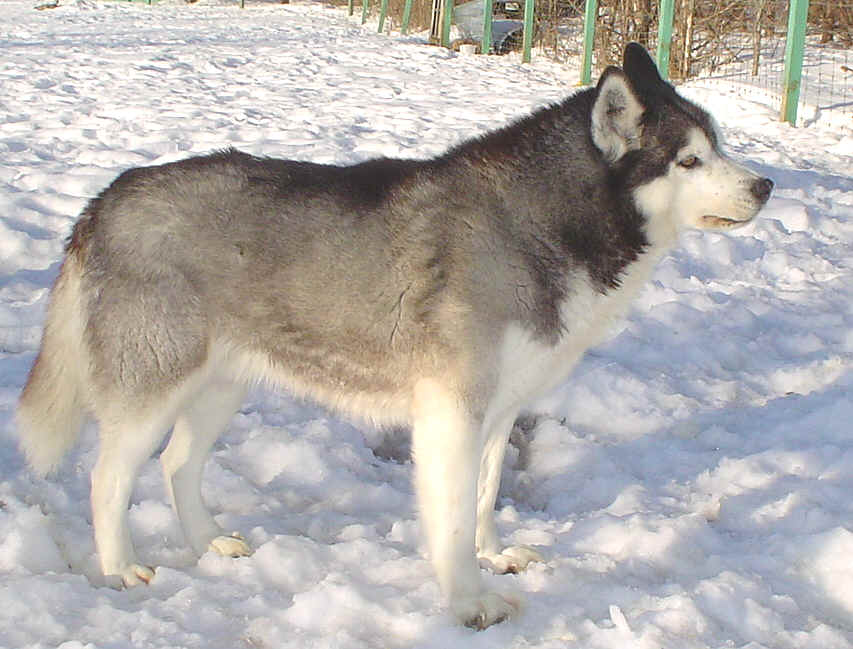
|
 Four photos @ left credited to Jeff Smith, Montague, Ontario, Canada.
|
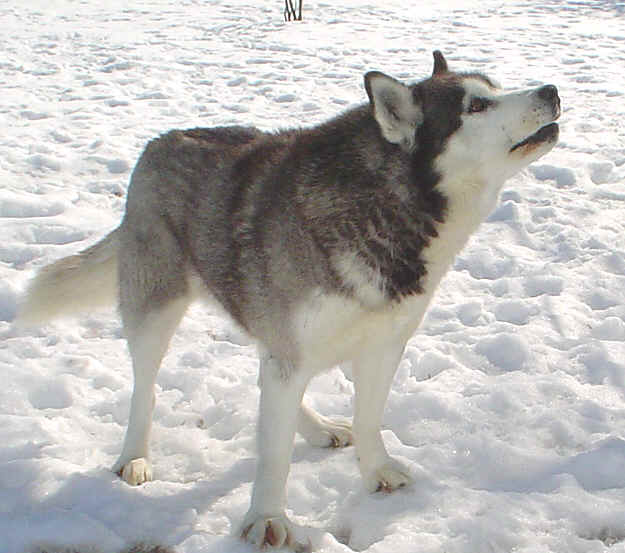 Four photos @ right credited to Hal MacGregor, Montague, Ontario, Canada. |
Canadian Wolf/Dog hybrids
When I lived with the Eskimos (now called Inuit) in the Arctic, I asked one how they crossed their dogs with wolves. He told me when a bitch is in heat they would take it about ten miles out in the tundra, secure it, and leave it there with enough meat to last a week. When they went back to get it, if it was still alive, it was bred with a wolf. If it was tore to shreds, a female wolf killed it.
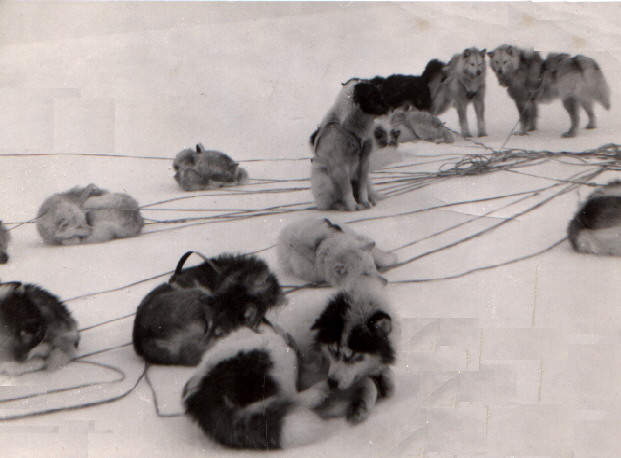
Note: Most natural Wolf/Dog crosses are the result of a male wolf and a female dog. This is because the male wolf is less discretionary, and male wolves will kill male dogs that trespass into their domain during their brief two week mating period. A popular fallacy is that a wolf cross will be untrustworthy and will invariable turn on its owner. Many wolf crosses make devoted pets, and are no more liable to become vicious than is any other type of dog. They all tend to be timid around people and are relatively hard to train. The overwhelming factor in any dog's personality is the treatment it receives at the hands of man.
 A Grey Wolf/Siberian Husky Cross.
A Grey Wolf/Siberian Husky Cross.
In Ontario, breeding wolves with dogs is now illegal, although first nations people still do it. These hybrids are considered better than pure dogs at running down wounded deer. Hybrids have a thin look to them as they tend to inherit the wolf tendency to remain slender. When they are used as sled dogs, there were continual fights between the pure Huskies and the half wolves.
In the far north, where Inuit used to regularly breed their sled dogs with wolves, it was done to strengthen blood lines as a village's dog pack would eventually get inbred. They are torn by two worlds, and are not accepted in either. They do not make good watch dogs as they tend to fear people. The Inuit never trusted them, so they used to give their children hammers, and told them to go beat on the dogs. This instilled a fear of humans which was deemed necessary given their wild ancestors. Their offspring may be born anytime of the year, and that alone will suffice to eradicate their progeny in the wild where pups have to be born in early Spring to make it through the next winter.
The above cross was "Keenai". She was caught as a yearling swimming from an island in a Quebec lake where Siberian Huskies were being bred with wolves. She has her summer coat here. She was eventually killed by a pack of pure Huskies. In the true wolf tradition, when outnumbered, she didn't fight back.
Another Siberian Husky/Wolf hybrid.
"NIKKO"

This is "Nikko". He is a young dog, and is 1 1/2 times higher than a full grown male Siberian Husky. He is well mannered, friendly with humans, and did not eat dead rabbits when I first got him so he has never had to hunt for his dinner. He has not been abused and has no bad habits. He was taught to sit on command.
This is the combination that is in such high demand. Notice the very long legs, long nose, and lean appearance. He would not be a very good long distance sled puller, as he exhibits the typical wolf physique for long distance loping and a sloping rear end for lightning maneuverability. Albeit, he would be a good companion dog.

Nikko's origins are a mystery. Was he dropped off and abandoned? Was he chasing deer and got lost? With no microchip, and no SPCA lost dog report, there was no chance of locating his last owner. He still had his juvenile winter coat when these photos were taken. In the only fight he got into while in my care, he almost killed a large Siberian Husky/Malamute cross within seconds. (He did not start the fight and no permanent damage was done). When attacked, he immediately jumped on the other dog and began tearing and shaking from above, a typical wolf behaviour.
Who do these wolf eyes belong to? To find out, continue scrolling down.
"Chilco"
This is a complete photo of "Chilco", a product of a German Shepherd female and a Grey wolf male. His German Shepherd instincts are definitely predominate. Compare this photo with the one far above of the CsV wolfdog.
Chilco comes from the Chilcotan area of British Columbia, and now lives near Lavington in the Okanagan Valley. He is very well-mannered and is very protective of the resident goats. He often carries a cat around in his mouth (whether the cat likes it or not). He is a very striking dog and appears at first to have a German Shepherd's body with a wolf's head.
"ABE"
This is "Abe", a product of a Siberian Husky and a Grey wolf. He lives near Hope in British Columbia. He is also a very striking dog and appears to be a very sound animal. He loves to ride around in his master's pickup.
"LOBO"
This is "Lobo", a wolf/dog (or a Brush wolf/dog) cross discovered near Hawkesbury, Ontario. He is probably the result of a runaway. He had no collar when found. He is a young full male, and behaves well with other dogs. He will grow rapidly and will probably weigh between 60 and 80 lbs (or more) when full grown. He may be the result of an arranged breeding, or perhaps from a "natural" brush wolf/dog encounter. (Explanation: Sometimes, a female dog in heat is bred by a wild brush wolf. This could happen as the result of a temporary runaway, or even if the female is tethered in the back yard. A dog in heat emanates an irresistible strong scent that will be noticed by any male (wolf or otherwise) within four miles, especially if the wind is right.
A neighbour used to have a Brush wolf/dog cross. He ran off every Spring but would show up in the Autumn when the pickings got too thin in the wild.
A female dog (or wolf or Coyote), can have a litter of pups with some from one father, others from another father. Hybrid wolves should always have special care, as they are more liable to roam than are non-wolf related dogs. Also, all young dogs that have any value at all should always be micro-chipped, so found dogs can be returned to their rightful owner. It should be remembered, all animal shelters have a policy of disposing of dogs after a short period if no one adopts them.
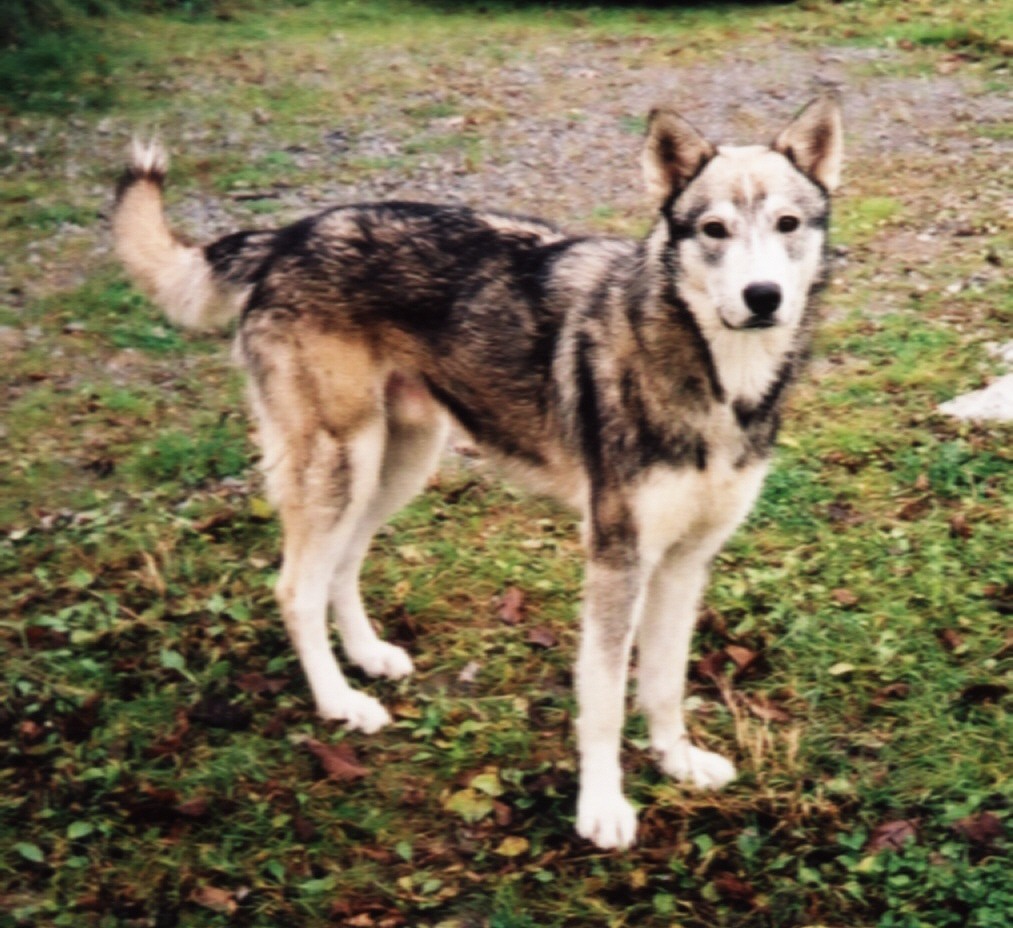
Notice the similarity between this dog and the previous one.
Arctic Wolf Canis lupus arctos
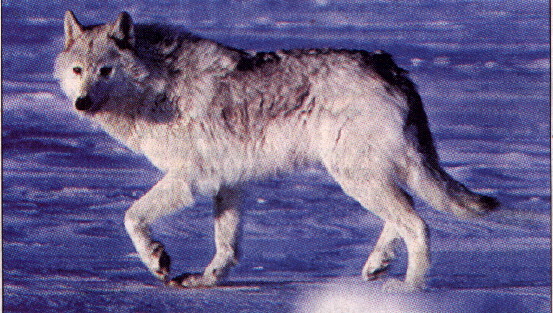
This northern-most representative of the Wolf family is, in fact, a white colour phase of the Grey Wolf that has become a recognized sub-species. They are smaller than a main-line Grey wolf of the interior Boreal forests (which sometimes occur as white also). Arctic Wolves are really an off-white, almost a dirty grey in summer, when they molt. They are spread from Baffin Island to Ellesmere Island and beyond.
Once, while stationed on a DEW Line Site on Baffin
Island, I had a unique experience with a solitary Arctic wolf:
One day, I decided to go ice fishing on the lake up behind our
site. As I walked deep in thought over the crest of a knoll, I almost bumped into a
wolf coming straight towards me. As I suddenly saw him, my mind had not registered
yet, and I immediately thought What is a dirty sheep doing up here in the high
Arctic?
Then it hit, me- A WOLF!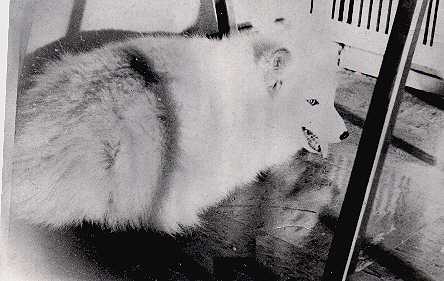
I don't really know which one of us was the more surprised. He immediately sprung backwards and started running away down the slope. I immediately flung myself on the ground, got out my binoculars and watched him through them. He stopped, and looked back at me. I thought he seemed a bit perplexed by my behavior although he kept running away. He stopped to look back every hundred feet or so until he disappeared over the hill on the other side of the valley.
I felt that this experience was very special; How many people can relate to an incident when a free wild Arctic Wolf shares such a moment in time? Two beings from different worlds, that would forever go their separate ways, but for one fleeting moment, we both experienced the mutual surprise of nearly bumping into each other alone on a cold winter's day.
One mention before leaving the Arctic wolf; What does an Arctic Fox do when it spots a wolf? It is so scared it voids on instinct.
This fellow (at right) was tempted inside with some meat on the end of a fishing line. We took some photos and then let him back outside, where I am sure he was much more comfortable.
With his winter coat, he was definitely quite out of his element.
The Largest Wolves in the World!
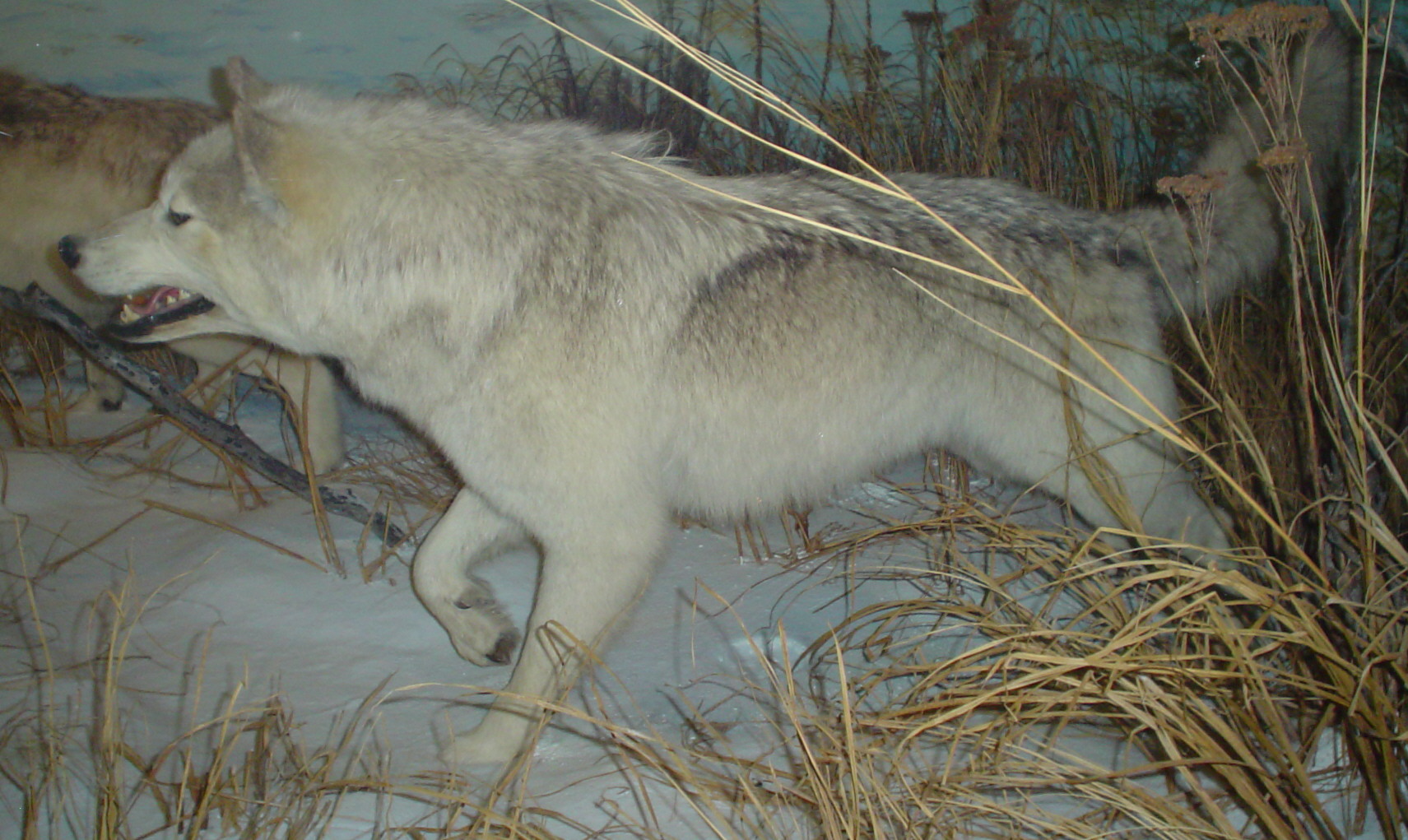
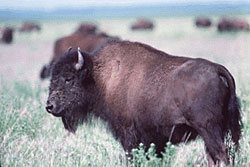 As part of Canada's system of national parks and national historic sites, Wood
Buffalo National Park is our country's largest national park and one
of the largest in the world. It was established in 1922 to protect the last
remaining herds of bison in northern Canada. Today, it protects an outstanding
and representative example of Canada's Northern Boreal Plains.
As part of Canada's system of national parks and national historic sites, Wood
Buffalo National Park is our country's largest national park and one
of the largest in the world. It was established in 1922 to protect the last
remaining herds of bison in northern Canada. Today, it protects an outstanding
and representative example of Canada's Northern Boreal Plains.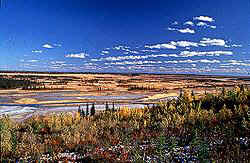
The presence of rare and superlative natural phenomena — including one of the largest free-roaming, self-regulating bison herds in the world, the only remaining nesting ground of the endangered whooping crane, the biologically rich Peace-Athabasca Delta, extensive salt plains unique in Canada, and some of the finest examples of gypsum karst topography in North America — led to the park's designation as a UNESCO World Heritage Site in 1983.
 Despite
their abundant presence, the wild animals of the park are elusive. Tracks and
scats can be seen along hiking trails and roads, but actual sightings are often
random and due to chance.
Despite
their abundant presence, the wild animals of the park are elusive. Tracks and
scats can be seen along hiking trails and roads, but actual sightings are often
random and due to chance.
The park is perhaps best known for its free-roaming wild bison herd, the largest self-regulating bison herd in the world. The bison wander freely through the forests and plains of the park. Although they can sometimes be viewed along the park roads, like the other wild animals they are often elusive and sightings cannot be guaranteed.

The non-wolf members of the Canid family
The True Jackals
Today, all the Jackals are found in Africa, Europe and south-west Asia. They are the oldest members of the Caninae family, and no doubt resemble the first ancestor of all Canids. The Grey wolf arose from Jackal-like Canids in North America that went north into the icy lands where survival forced cooperation, and a larger size. The Pleistocene era gave rise to huge herbivores and similarly huge carnivores. Wholly Mammoths, Mastodons, Giant Bison, Elk, Moose, Caribou, and Giant Beaver, all were fair game to those who could rise to the occasion. The Jackal's direct predecessors did.
Side-Striped Jackal Canis adustus
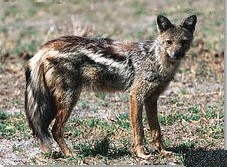
![]()
The Side-striped Jackal is a greyish brown to tan with a white stripe from the front legs to the hips and has a dark tail that has a white tip. The Side-striped Jackal can weigh from 14 to 30 lb. Males tend to be larger than the females. It is social within small family groups, communicating via yips, "screams" and a soft owl like hooting call. It is nocturnal, and rarely active during the day.
The Side-striped Jackal lives in the damp woodland areas along with grassland, bush and marshes. The Side-striped Jackal eats fruit, insects, and small mammals such as rats, hares, and birds. It will go for the young of animals such as warthogs and gazelles. It will often follow big cats to scavenge their kills, but has never been observed taking down larger prey on its own.
The breeding season for this species depends on where they live; in southern Africa breeding starts in June and ends in November. The Side-striped Jackal has a gestation period of 57 to 70 days with average litters of 3 to 6 young. The young reach sexual maturity at 6 to 8 months old, and typically begin to leave when 11 months old. The Side-striped Jackal is among the few mammal species that mate for life, forming monogamous pairs. There are six recognized subspecies of this Jackal.
Black-backed Jackal Canis
mesomelas
Meet the oldest member of the
Caninae family.
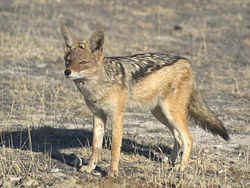
The Black-backed Jackal (Canis mesomelas), also known as the Silver-backed Jackal is a mammal of the order Carnivora. The Black-backed Jackal inhabits two areas of the African continent separated by roughly 900 kilometers. One region includes the southern-most tip of the continent including South Africa, Namibia, Botswana, and Zimbabwe. The other area is along the eastern coastline, including Kenya, Somalia, and Ethiopia.
As its name suggests, the species' most distinguishing feature is the silver-black fur running from the back of the neck to the base of the tail. The chest and under parts are white to rusty-white, whereas the rest of the body ranges from reddish brown to ginger. Females tend not to be as richly colored as males, like many other animals, such as ducks. The winter coat of adult males develops a reddish to an almost deep russet red color.
The Black-backed Jackal is typically 14-19 inches (32–42 cms) high at the shoulder, 45-90 centimeters (18-36 inches) long and 15–30 lbs (7–13.5 kilograms in weight. Specimens in the southern part of the continent tend to be larger than their more northern cousins.
The Black-backed Jackal is noticeably more slender than other species of jackals, with large, erect, pointed ears. The muzzle is long and pointed. The dental formula is 3/3-1/1-4/4-2/3=42. Scent glands are present on the face and the anus and genital regions. The Black-backed Jackal has 6-8 teats.
The Black-backed Jackal usually lives together in pairs that last for life, but often hunts in packs to catch larger prey such as the Impala and other antelopes. It is very territorial; each pair dominates a permanent territory. It is mainly nocturnal, but it comes out in the day occasionally. Its predators include the Leopard and humans. Jackals are sometimes killed for their furs, or because they are considered predators of livestock.
Fossil records indicate the Black-backed Jackal is the oldest member of the Caninae family. Are these the same as those original North American Canids that ventured into Siberia? Watching this little fellow in its daily behavior should transport any Canidophile back five million years to a time when Eucyon roamed the plains of Miocene North America. Compare the photo above to that of Eucyon at the very beginning of this article.
Bush Dog Speothos venaticus

The Bush Dog has soft long brownish-tan fur, with a lighter
reddish tinge on the head, neck and back and a bushy tail. The underside is
dark, sometimes with a lighter throat patch. Adults typically have 55–75 cm of
head and body, plus 13 cm of tail, and weigh 5–7 kg. Legs and snout are short
relative to body length: the typical height is only 25–30 cm. 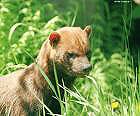
It is a carnivore, and hunts during the day, preferably in wet savannahs and tropical and equatorial forests. Its typical prey is the Paca (Agouti paca), a large rodent. Although the Bush Dog can hunt alone on occasion, it is usually found in packs of up to 10–12 individuals, which can bring down much larger prey. It is a good swimmer (thanks to its webbed feet). It uses hollow logs and cavities (e.g. Armadillo burrows) for shelter. Pack-mates keep in contact with frequent whines, perhaps because visibility is poor in the undergrowth where the animals typically hunt.
The gestation period is 63 days, and a litter can have up to six dark grey pups. Lactation lasts approximately 8 weeks. The Bush Dog is sexually mature at 1 year and lives for about 10 years. This unique Canid may be the only living descendent (or relative) of the Dire wolf.
African Hunting Dog Lycaon pictus
 The
African wild dog or African hunting dog, Lycaon pictus, is a carnivorous
mammal of the Canid family, found only in Africa, especially in scrub savanna
and other lightly wooded areas. It is also called Cape hunting dog,
spotted dog, or painted wolf in English, Wildehond in Afrikaans, and Mbwa mwitu
in Swahili. It is the only species in the monotypic genus, Lycaon.
The
African wild dog or African hunting dog, Lycaon pictus, is a carnivorous
mammal of the Canid family, found only in Africa, especially in scrub savanna
and other lightly wooded areas. It is also called Cape hunting dog,
spotted dog, or painted wolf in English, Wildehond in Afrikaans, and Mbwa mwitu
in Swahili. It is the only species in the monotypic genus, Lycaon.
The wild dog has a fur with an irregular pattern of black, yellow, and white, distinctive for each individual. Lycaon pictus means "painted wolf" in Greek. It is the only canid species to lack dewclaws on the forelimbs.
Adults typically weigh 17-36 kilograms (37-79 pounds).
A tall, lean animal, they stand about 30 inches (75 cm) at the shoulder, with a
head and body length averaging about 40 inches (100cm) and a tail of 12 to 18
inches (30-45cm). Animals in southern Africa are generally larger than those in
eastern or western Africa.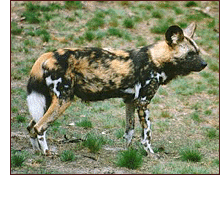
There is little sexual dimorphism, though judging by skeletal dimensions, males are usually 3-7% larger. They have a dental formula of a total of 42 teeth. The premolars are relatively large compared to other canids, allowing them to consume a large quantity of bone, much like hyenas.
The heel of the lower carnassial M1 is crested with a single cusp, which enhances the shearing capacity of teeth and thus the speed at which prey can be consumed. This feature is called trenchant heel and is shared with two other canids: the Asian Dhole and the South American Bush Dog. A study established that the African Hunting dog has a bite force of 142, the highest of any similar carnivorous mammal.
Wild dogs reproduce at any time of year and peak between March and June during the second half of the rainy season. 2-19 pups can be born per litter, though 10 is the most usual number. Gestation is approximately ten weeks and pups are usually born between March and July. The time between births is usually 12-14 months, though it can also be as short as 6 months if all of the previous young die.
Pups are usually born in an abandoned den dug by other animals. Weaning takes place at about 10 weeks. After 3 months, the den is abandoned and the pups begin to run with the pack. At the age of 8-11 months, they can kill small prey but they are not proficient until about 12-14 months, at which time they can fend for themselves. Pups reach sexual maturity at the age of 12-18 months.

Asiatic Wild Dog Cuon alpinus
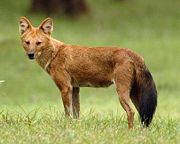
The Dhole typically weighs 12-20 kilograms (26-44 lbs,
and measures 90 cms (35 in.0 in body length, and 50 centimeters (20 inches)
shoulder height. The tail
measures 40-45 centimeters (16-18 inches) in length.
There is little sexual dimorphism.
The Dhole has a broad, domed skull and a short, broad muzzle. The bones of the
forehead and upper jaw are "swollen", producing a dish-faced profile.
The hooded eyes have amber or light brown irises, and the ears are large and
rounded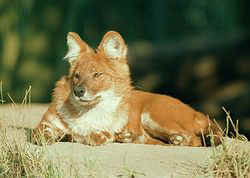
Evolution: Remarkably, the Dhole is an ice age survivor like the Grey wolf. The Sardinian Dhole was a descendant of the European Dhole, both of which are extinct. The Dhole once ranged all of Eurasia and North America during the late Ice ages.
Range & Habitat: The Dhole ranges in eastern Asia from India to China, and as far south as Java. They do not occur father than 54' N in Russia Historically, they ranged throughout the Indian peninsula, north into Korea, China and eastern Russia, and southeast through Malaysia and Indonesia, as far south as Java. Although data on their current range and population is lacking, their current range seems to be greatly reduced, with populations being fragmented.
The greatest remaining populations are found in Central
(especially in the Highlands), Western and Northern Pakistan and Southern India.
 Dholes
prefer forested areas of their range. They occur in dense montane and alpine
forests in Russia and Thailand, and scrub jungles in India. Open forests
adjacent to grassy meadows that support their prey are prime territory for the
Dhole.
Dholes
prefer forested areas of their range. They occur in dense montane and alpine
forests in Russia and Thailand, and scrub jungles in India. Open forests
adjacent to grassy meadows that support their prey are prime territory for the
Dhole.
Habitat: The Dhole exploits a large variety of habitats, reflecting its adaptability. It normally inhabits dry and moist deciduous forests and thick jungles, as well as tropical rain forests, which all provide better cover for hunting. It inhabits areas of primary, secondary, degraded, evergreen, and semi-evergreen forms of vegetation, and dry thorn forests, as well as scrub-forest mosaics. It can also survive in dense alpine forests, meadows and on the open steppes of Kashmir and Manchuria.
As the second part of its Latin name, alpinus, suggests, the Dhole is often found in hilly or mountainous regions. The Dhole likes open spaces and during the day they can often be found on jungle roads and paths, river beds, and in jungle clearings. The Dhole inhabits the widest range of climates in the canid family – from freezing cold to tropical heat, but is not recorded in deserts.
Factors which influence habitat include water, the presence of other large predators, sufficient prey (plentiful medium to large ungulates), local human population, and suitable breeding sites.
Subspecies- Cuon alpinus alpinus(Pallas, 1811) -- Eastern Russia
- Cuon alpinus adustus (Pocock, 1941) -- Northern Myanmar & Indo-China.
- Cuon alpinus dukhunensis -- India, south of the Ganges river
- Cuon alpinus fumosus (Pocock, 1936) -- Western Szechuan, China & Mongolia.
- Cuon alpinus hesperius (Afanasjev and Zolotarev, 1935) -- Eastern Russia & China
- Cuon alpinus infuscus -- Southern Myanmar, Malaysia, Thailand & Vietnam.
- Cuon alpinus javanocus -- Java
- Cuon alpinus laniger (Pocock, 1936) -- Kashmir & Southern Tibet
- Cuon alpinus lepturus (Heude, 1892) -- China, south of the Yangzhe river
- Cuon alpinus primaevus -- Himalayan regions of Nepal, Sikkim and Bhutan.
- Cuon alpinus sumatrensis (Hardwicke, 1821) -- Sumatra
The Stuff Of Legends
It is the Grey wolf that has inspired men to fear, love, denigrate, admire, and despise. This magnificent animal has populated the earth in an area second only to man. Myths have risen from the earliest times of the 'noble wolf', the creature that competes with man for game, the creature that, when running in a pack, bows to no other animal.
'Werewolves', 'man-eating wolves', 'Red-riding hood's nemesis, nothing stirs the blood in man more than the thought of being ravaged by a pack of wolves. Yet cases where a human has been set upon by a wild wolf are extremely rare. Misunderstood, trapped, poisoned, persecuted, and shot from helicopters, their territory laid barren by man, this animal still manages to survive by its own devices.
It was from the ranks of wild Grey wolves that man first domesticated animals. The progeny of the wolf has become man's best friend, the dog. Perhaps, it was more from the jealousy of an efficient competitor that man turned against the wolf, than from the fear of being the hunted. Regardless, man the hunter has often become man the exterminator in his selfish quest for supremacy among all living creatures.
Perhaps the greatest fallacy that man has ever created is the idea that all animals were put on earth for his use.
Chief Seattle, of the Suquamish First Nations Tribe said:
"What is man without the beasts? If all the beasts were gone,
men would die from a great loneliness of spirit.
For what ever happens to the beasts, soon happens to man,
All things are connected."

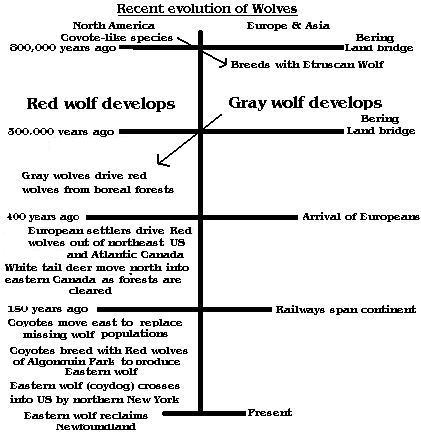
A special thanks to all those wonderful people who have contributed to this chapter over the years.

